#1880s Impressionism Sets
Text

Trois femmes aux ombrelles
And we're back at the regular 1880's fashion with this set which inludes bustle skirts in 3 lenghts, 2 skirt overlays, 3 flower accessories, a parasol and an umbrella !
More pics and download below
As referenced in the title, this set was inspired by Marie Bracquemont’s painting : Trois femmes aux ombrelles ou Les Trois grâces / Three Ladies with Parasols or Three Graces, 1880.
Thanks to @javitrulovesims for making the perfect pose for this set !
——————————— Skirts ———————————

———————————————————————————
Once again, these skirts have a slight bustle shape which would best fit for the natural form era : roughly 1875 - 1883 ; (well actually, the size of the bustle is dependant on the size of the sim’s butt so do with that what you will). They are more ornate than my Cueillette skirts featuring some gathered layers and trims typical of the period, so they would be better suited for higher class people or more dressed up occasions.
And as always I give you 3 versions with each a different lenght to have more teen options and worker friendly options . The short one end mid calf, the medium one is ankle lenght and the long is full lenght.
74 swatches : 22 solids, 10 floral, 6 plaid, 25 striped & 11 polka dot patterns
3 lenghts : S, M & L
————————— Skirt Overlays —————————

———————————————————————————
These two overlays will allow to respectively change the gathered layers and the trim swatches in order to channel the trim crazy period that were the 1880's.
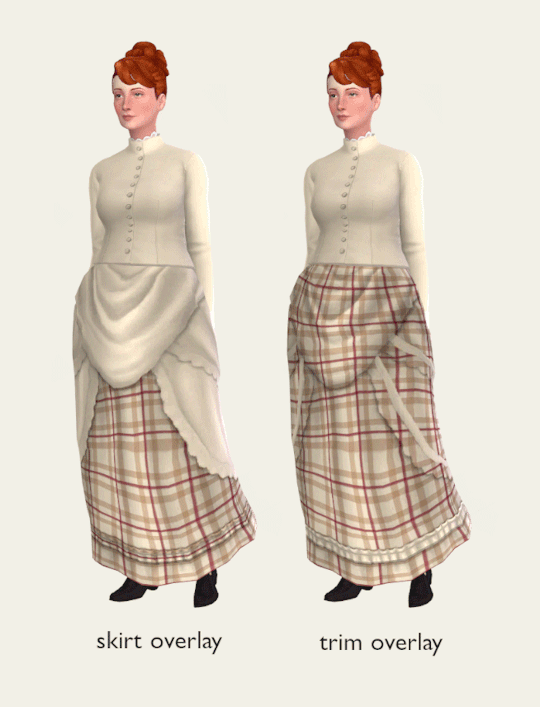
in the middle finger section
74 swatches for the skirt overlay : 22 solids, 10 florals, 6 plaids, 25 stripes & 11 polka dots patterns
22 solid swatches for the trim overlay
———————— Flower Accessories ————————

———————————————————————————
To properly channel Marie Bracquemond's painting I needed a bunch of flower accessories so you will find 3 accessories in this set : a hair flower, a collar flower and a boutonnière. In my opinion these are pretty timeless and can suit a wide array of looks as portrayed in the pictures below.
These are all edits of @the-melancholy-maiden's Hair Flowers Through the Ages Part 2 thanks to her very open TOU.
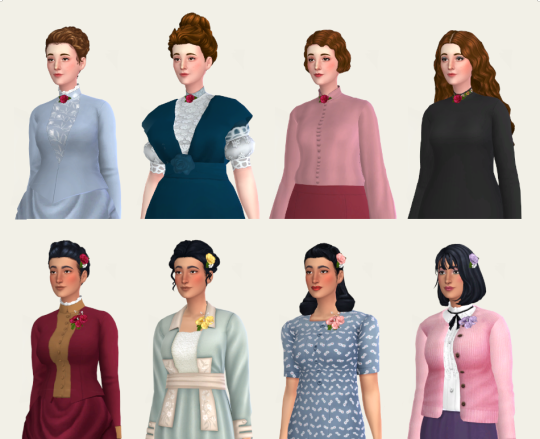
none of these are compatible with hats
51 swatches : the-melancholy-maiden's original 29 colors and my 22 colors
the collar flower and the boutonnière are in the necklace section
the hair flower is in the hat section, available for both female and male frames
the hair flower is hat slider compatible
———————— Parasol & Umbrella ————————

———————————————————————————
I made both an umbrella and a lacey parasol (using Javi's texture). These are rather timeless too I think, they are definetely suited for late victorian and edwardian eras.
These are both edits of @javitrulovesims's Meiji Komorebi Accessory Parasol, thank you Javi !
NOT compatible with necklaces, earrings, piercings or anything using the same UVmap (such as kijiko's lashes unfortunatly)
in the right index finger section
45 swatches : 2 colors for the frame and handle, 22 for the canopy and 1 fully black swatch
———————————————————————————
Download : dropbox — simfileshare
———————————————————————————
#my cc#ts4cc#ts4 historical#ts4 clothes#ts4 accessories#sims 4 historical#sims 4 clothes#sims 4 accessories#maxis match#decade challenge#1880#clothes#timeless#accessories#teen#grown up#1880s Impressionism Sets
604 notes
·
View notes
Text
Sometimes something you hear a random person say in a museum sticks to you so much you buy a magnet and never forget it.
Let me set the stage
I spontaneously went to an art museum, and it had an exhibition on impressionism. It showcased works from classic impressionist masters mixed in with nordic impressionists.
I walk up to what is obviously the crown jewel of this exhibition. It has been given it's own wall, with good spot lighting and a big junk of text beside it. I orientate myself so that I can take in this painting.
The painting is Les glaçons (Floating ice) by Claude Monet.
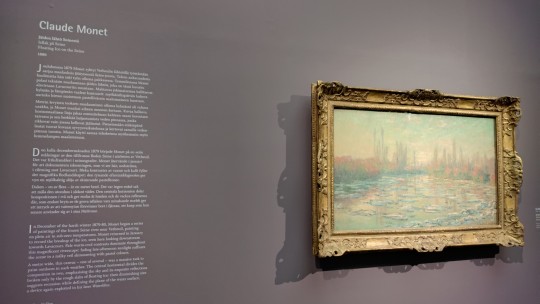
A pair of youngsters walk up to the painting. I think they are somewhere between 16-20. They had cool outfits, emo-ish style. They stop to look at the painting. Then one says to the other in finnish:
"This is fine/fancy but in my opinion meaningless." (Tää on hieno, mutta musta merkityksetön)
I, a person who has visited Monet's house in France, stand there, baffled by this. I'm white guy blinking at this person. In my mind I say: "Bro, that's Monet!!"
I kept examining the painting for solid five minutes, thinking about what that person had said. I was conflicted because while I disagreed hard, because a scenery painting in my opinion can have a fuckton of meaning, I could see where they are coming from, and in some sense, I saw a little spark of truth in that nihilist take. More of my thoughts are behind the read more link.
In order to never forget this moment (and perhaps out of some sort of spite) I bought a magnet with the painting on it.
Now whenever I see it on my fridge I think "fancy but meaningless...."
The thing is, while I don't think thats honestly might not always be the best way to look at art, and especially older paintings, there is some truth to those words. It's a very nihilistic take, but I find myself unable to completely disregard it. We have beautiful things in the world where their only meaning is to be pretty. They don't have any deep meaning given to them. Beauty is nothing but an obscure subjective experience we project into things. A fancy decorated hand mirror is indeed "fancy but meaningless". It's just a pretty object. And in some sense, that applies to art as well.
But then again, couldn't the meaning be that these beautiful things bring us joy, and turn the mundane into something that sparks happiness in us? Is that not meaningful in itself? Is the experience of beauty meaningless when it can awake so many emotions in us? Could it be that the purpose of this piece of art isn't to convey a deep message about society, but to capture a passing moment of natural beauty into something that will last long after the moment is gone? Or perhaps for the artist to show us what he he sees in nature, how the colors play, how there are no lines how light plays on the water's surface? In the text it's said that Monet had to paint this in freezing weather, and it was a huge labour, undoubtedly also physically. But he withstood the cold for art, to get his vision and to capture the moment. Saying the painting is meaningless is like completely disregarding the actual hard labour and years of practice that was needed in order to produce this particular piece.
It it not about being a physical manifestation of the artist's work, and technical skills and mastery of depicting light and color? Fancy, and therefore meaningful.
#note that I am not critisising the person becuase I can kinda see where they are coming from#but it also very much felt like a wet cloth had been tossed on my face#i keep thinking what they think makes a painting meaningfull? that it debicts something societally important?#that it has a political message?#are all scenery paintings fancy but meaningless?#skull rambles#claude monet
13 notes
·
View notes
Photo
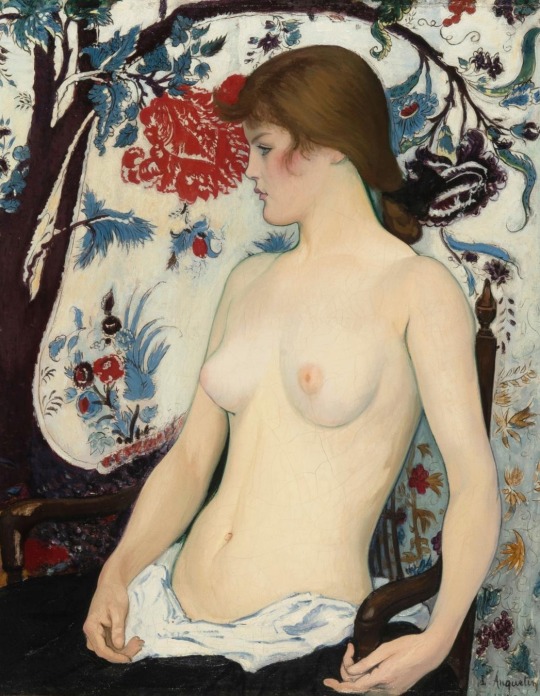
Louis Anquetin (1861 - 1932)
“Torse de Jeune fille, Juliette Vary” c1890
Louis Anquetin was among the group of artists which Vicent Van Gogh referred to as “painters of the petit boulevard”, a term coined by the latter in the mid-1880s.
These artists all experimented with avant-garde techniques, drawing subjects from Parisian contemporary life. In the same circle were Emile Bernard and Henri de Toulouse-Lautrec, with whom Anquetin had studied at the atelier of Fernard Cormon in Montmartre.
Anquetin was widely admired by his fellows. In the words of John Rewald, “his friends, especially Lautrec, admired the ease and forcefulness with which he expressed himself as an artist, as well as the passion with which he set out to invent painting all over again. Lautrec went so far as to say that since Manet no painter had been so richly gifted as Anquetin” (John Rewald, Post-Impressionism, New York, 1978, pp. 29-30).
113 notes
·
View notes
Text


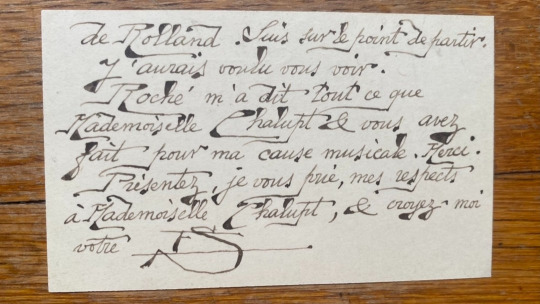
OTD in Music History: Composer and French cultural icon Erik Alfred Leslie Satie (1866 - 1925) is born in France.
The son of a French father and a British mother, as a young man, Satie briefly studied at the Paris Conservatory -- but was an undistinguished student who failed to obtain a diploma.
In the 1880's, he worked as a cafe pianist in Montmartre, where he began composing solo piano works, including his most famous set, the "Gymnopedies." (He also wrote music for a Rosicrucian sect to which he was briefly attached.)
After a spell during which he composed little, Satie enrolled at a second music academy -- Vincent d'Indy's (1851 - 1931) "Schola Cantorum" -- as a mature student. His studies there were far more successful than those at the Conservatory, and from 1910 onward he became the focus of successive waves of young composers who were attracted by his unconventionality and originality.
Among them were the group known as "Les Six," and a 1915 meeting with Jean Cocteau (1889 - 1963) led to the creation of the ballet "Parade" (1917) for impresario Serge Diaghilev (1872 - 1929), with music by Satie, sets and costumes by Pablo Picasso (1881 - 1973), and choreography by Leonide Massine (1896 - 1979).
Satie had a tremendous impact on pushing French music away from lush post-Wagnerian impressionism and towards a sparer, terser style. Among those directly influenced by him during his lifetime were Maurice Ravel (1975 - 1937) and Francis Poulenc (1899 - 1963), and he is also often cited as influence on later composers such as John Cage (1912 - 1992).
Satie was also one of the first "Dadaist" cultural figures -- some of his later works were given purposely absurd titles like "True Flabby Preludes (for a Dog)" (1912) and "Sketches and Exasperations of a Big Wooden Man" (1913).
PICTURED: An original copy of one of Satie's printed business card, identifying him as "Erik Satie, Composer of Music." He wrote a short social message on this copy in his trademark calligraphic handwriting.
#Erik Satie#Satie#composer#classical composer#classical music#bel canto#music history#classical studies#classical composers#Gymnopédies#Gnossiennes#Paris Conservatoire#Notre-Dame de Paris#Prélude#Danses gothiques#Enfantines#Allegro#Valse-ballet#Fantaisie-valse#Premier Menuet#Orchestra#Danse#Musique d'ameublement#Cabaret songs#songs
16 notes
·
View notes
Note
The one thing that I want to know after reading about Nobby’s NRM friends is his relationship with the LNWR and midland engines.
Also I’m just imagining a funny what-if if he was shunting alongside Cornwall, Hardwicke, and 49395, and everyone prays that world war 3 doesn’t start lol.
I hate to disappoint, but ‘boringly realistic’ is as you know my brand I don’t see those relationships as being that spicy.
I can definitely see the NRM having a recurring theme where some kindly, enthusiastic, naive soul is like “hey! let’s put all the reeeally old engines next to each other for a while and they can reminisce about Victoria and Albert getting hitched, or whatever! :)” and despite warnings they do it and then all the Reeeeally Old Engines are just staring icily at each other in a sort of eight-way armed standoff, each knowing that the first one to speak is going to set off a relitigation of stale old politics and grievances (from both their working and preservation careers) they all know should be buried sixty years ago, except here they are, all kinda itching to fight ‘em again, but also There Are People Around, and, more importantly, There Are Young Engines Around. Wouldn’t want to set a bad example for impressionable young things like Gazelle and Truro.
But the atmosphere? It’s chilly.
That, however, is the reeeeeally old crowd. It doesn't even include the good-natured M.R. lot.
There is no feud between the Furness and Midland survivors. It was never that severe between them, anyway. In fact, back in their working days F.R. No. 4, Coppernob’s brother, would ramble about his admiration of the glamorous Midland 1757 ‘Beatrice’. Remembering his twin’s old fanboy crush, Nobby sank into a deep funk for two days when he heard Beatrice had been dismantled. (This was right before Grouping, and Nobby had no idea just how scrap-happy life was about to get.)
Back in Coppernob’s working days there was just the usual neighborly rivalry when you have two railways full of puffed-up steam engines. The M.R. loved when it finally had a rival company that they could look down upon for underpowered engines—it made such a nice change from their situation at all the other junctions ('The M is for Midland, with engines galore/Two on each train, and begging for more!'). The F.R. rolling stock resented the existential threat that the Midlanders represented, and resented some of their snubs and titters at their rather sorry ‘boat trains’ even more. But the whole thing largely simmered down sometime in the 1880s when the Furness directors firmly told the M.R. that they could pay them roughly six bajillion dollars for their company or they could fuck off, and the M.R. chose the latter option.
Coppernob and 158 are the only two still alive who even remember the thing. There is no grudge. 158 never even worked those regions, and even if she had it’s unlikely Nobby would hold it against her. He can be petty—but he’s not that petty. And 158 couldn’t hurt a fly, let alone stir up century-old bad blood. Among other things, it would be unsporting. There are a good few pre-Grouping Midlanders in the National Collection, and then there’s Nobby all by himself. That would just be mean.
So Nobby is on good terms with all the surviving Midlanders that he's met, and positively cozy with their composite six-wheeler. If he and 158 haven’t become friends, it’s largely down to the fact that, while they have a lot in common, it’s the sort of life experiences that are very painful and they just haven’t gotten round to opening up to each other in that way yet. Maybe give them another fifty years and we’ll see.
But then there’s the L.N.W.R., haha. The Midland just wanted to buy them out and take over their entire outfit, pah! You can fight that. What the L.N.W.R. did hurt way worse. The F.R. had to make a huge noise and fuss to get the 'old' North-Western to even notice them.
The keynote of the F.R.’s rivalry with them in the old days was that the London and North Western was one of the greatest railways in the world and the truth is that the Furnessians admired them very much. The F.R. took a lot of cues on how to do things from their great neighbors to the south (except—unfortunately, from the engines’ point of view—they never bothered to try to imitate the Crewe Works. But, for example, even Nobby’s preservation was itself a very ‘big North-Western’ move on their part). The scrappy, spirited Furnessians were hate-‘em-‘cause-they-ain’t-‘em. They aspired to be them, they never would be them, and whenever the L.N.W.R. noticed their existence they found the F.R.’s little attempts to compete with them entertaining. (You can maybe see why Nobby has a soft spot for James.) Nobby spent much of his first forty years running on pure spite of the ‘North-Western.’ He was always enormously (and not unjustly) proud of his life’s work in helping the F.R. expand and succeed—but that pride was always shattered bitterly whenever he ran into boastful L.N.W.R. stock, who never failed to remind him, with great heartiness, how poor and tardy and out-of-date their whole outfit was. It would throw his whole system out of order for days. He and the rest of his lot hated them—and they simply thought of the Copper-Nobs (when they thought of them at all) as quaint, funny, mildly annoying little things.
This sort of rivalry is just the worst.
The power imbalance has straightened out since 1900, though. Coppernob himself (against all expectations back in the 1840s, when the F.R. had like twelve miles of track and not quite as many coaches) was newsworthy by the time he was withdrawn, if from nothing but the sheer stubbornness of working what was at the time the longest career on British rails.
A quarter-century later, he and Columbine turned over a new leaf when they were put on display next to each other at the Wembley Exhibition—it was really nice for both of them to put away all the old nonsense and actually get to know each other, and they are penpals to this day. (They were also insufferably haughty about their good sense and deportment. The only reason it wasn’t on sight for the two of them was because Flying Scotsman and at least one of the Castles were there, already making a “scene.” Coppernob and Columbine bonded immediately as they basically pretended that they had never been so silly as that, and why were the new Big Four so eager to produce engines with more tractive effort than sense, and yes indeed, back in their day they knew how to express their differences with grace, and—)
It was at the Exhibition of ’25 that the world got to see Nobby’s “guest manner” in action. His whole crotchedy-grandpa-with-a-heart-of-gold shtick that he’d developed while stuck at Barrow Central proved a huge success. (The L.N.W.R. emeriti had mostly been departmental engines once withdrawn—they'd had to develop some public relations game too, but 'talking to visitors' hadn’t been literally their only duty they’d had to practice 24/7 for the past eighteen years.) It sure impressed the hell out of Columbine, and it inspired her to up her game—and to go home and make sure the rest of her railway elders did too. So yeah, ironically enough we did wind up in a situation where (for once! a-men) it was the proud Crewe engines who were scrambling to keep up with a Copper-Nob.
(It’s lucky that Nobby didn’t really grasp the scale of his success at Wembley and indeed the influence he had on the entire British preservation circuit until much later. By the time he did it was well after the Barrow Blitz and he was so famous that it didn’t really matter that his dome grew three sizes that day. Getting bombed? That wasn’t heroic, he didn’t bloody do anything. Becoming as popular as the entire L.N.W.R. lot put together? Now, that. That’s a proper ego boost!)
Most of Nobby’s London and North Western contemporaries—the ones with whom he ever had any real enmity, the ones who used to humiliate him and his—are scrapped. But there are significant strains on their modern truce. He and Cornwall, even though they Conduct Themselves Appropriately, have such a foul enmity poisoning the air between them that they are always housed in different museums. Hardwicke is a generation after all these grand old ‘C’s and perhaps would have been on neutral terms with Coppernob, especially due to their mutual friendships (including with Columbine) and to the sense, shared by all the M.R. engines, that it would be just vulgar to gang up on Coppernob when he’s a party of one… except Nobby once gossiped in Hardwicke’s hearing about the long-dismantled Lady of the Lake (“ ‘Lady of the Lake,’ pah. ‘Witch of the Lagoon,’ more like!” — h/t @houseboatisland) Understandably Hardwicke found this pretty disrespectful and came to the conclusion that Coppernob’s double-edged tongue makes two-or-three on one a perfectly fair match, in his case! While Hardwicke is not as deep in the feud as Cornwall, he does of course back up his old fleetmate and mentor whenever conflict breaks out.
Nobby had no grudge against the old Crewe saddletank on principle—he’d never even heard of her until the 1950s—it’s her personality that led to him rejecting her. (He’s not alone; she’s pretty widely disliked. 1439 has seen and participated in far more scrappings than any living being should and she is, to put it mildly, a little too quick to share a morbid memory.) ‘Pet,’ however—the other old Crewe shunter, the narrow-gauge one—is a much more personable engine and popular with just about everybody; she reminds Nobby in particular of Poppet.
Unlike Nobby’s great success with the M.R. coaches, the old Wolverton carriages maintain the old snobbery in full measure and do not deign to speak to any engines they consider inferior to the L.N.W.R. engines who used to handle them. They've even snubbed the Rocket (yes, the real one), so we can expect that quaint little Coppernob will be in that scorned category forever. (He hasn’t exactly lost sleep over it. I’m not 100% sure he’s even noticed the silent treatment—it took him decades to strike up a conversation with his friend the Midland composite. Engine classism ftw!)
17 notes
·
View notes
Text
The simultaneous rejection and embrace of womanhood
The idea for this theme derived from my set of photos with my mom as the main subject: high school-senior-mom, wedding-day-mom, and after-I-was-born-mom. It demonstrates her growth into womanhood wonderfully, and as a girl who’s stepping into her 20s, I’m on the path of discovering what womanhood means to me too.

Berthe Morisot, Woman at Her Toilette, 1870-1880. Oil on canvas.
Impressionism

Mary Cassatt, Mother and Child, 1905. Oil on canvas.
Impressionism
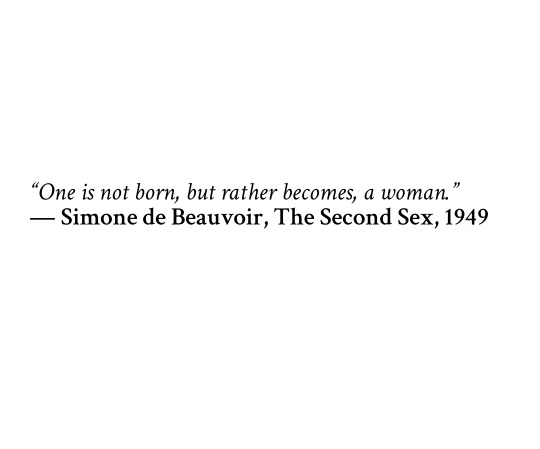
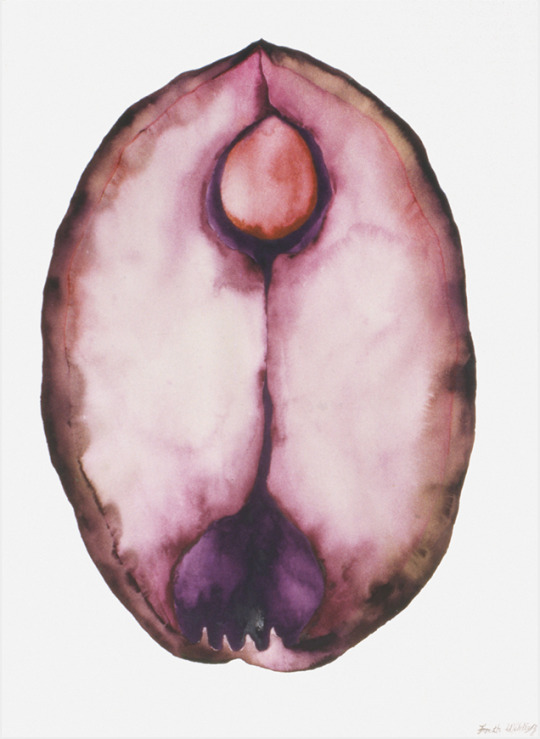
Faith Wilding, Peach Cunt, 1971. Watercolor on paper.
Contemporary Art - Feminist Art Movement
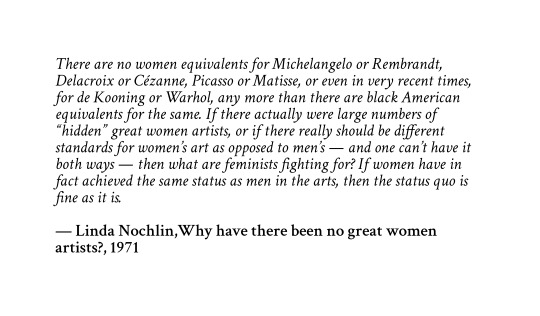


Carrie Mae Weems, The Kitchen Table Series, 1990. Photography.
Contemporary Art - Feminist Art Movement

High school-senior-mom, 1996. Photography.
Family artifact

Nancy Spero, 'Sheela-Na-Gig at Home', 2000. Handprinting and printed collage on paper, installation with underwear and clothesline.
Contemporary Art
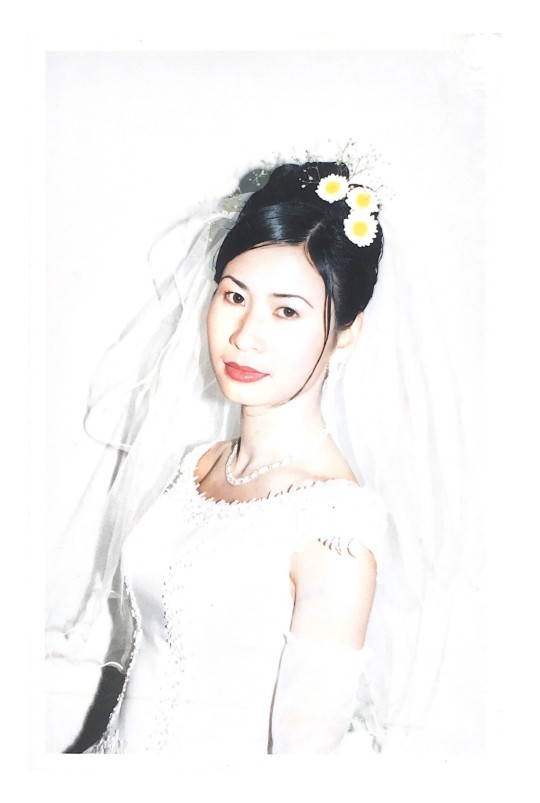
Wedding-day-mom, 2002. Photography.
Family artifact

After-I-was-born-mom, 2003. Photography.
Family artifact

Sa’dia Rehman, Divine Guidance, 2010. Sculptural installation.
Contemporary Art

Marcy Chevali, With a Little Pink Spot, 2013. Scuptural installation.
Contemporary Art


Fleabag (TV Show), 2016 - 2019

Hester Finch, Motherhood & Pregnancy. Soft pastels on paper.
Contemporary Art
WHEN I SAY THAT WE ARE ALL TEEN GIRLS
by Olivia Gatwood, 2019
what I mean is that when my grandmother
called to ask why I didn’t respond to her letter,
all I heard was, Why didn’t you
text me back? Why don’t you love me?
And how can I talk about my grandmother
without also mentioning that if everyone
is a teen girl, then so are the birds, their soaring
cliques, their squawking throats,
and the sea, of course, the sea,
its moody push and pull, the way we drill
into it, fill it with our trash, take and take
and take from it and still it holds us
each time we walk into it.
What is more teen girl than not being
loved but wanting it so badly
that you accept the smallest crumbs and call
yourself full; what is more teen girl than
my father’s favorite wrench, its eternal loyalty
and willingness to loosen the most stubborn of bolts;
what is more teen girl than my mother’s chewed
nail beds, than the whine of the floorboards in her
house?
What is more teen girl than my dog, Jack,
whose bark is shrill and unnecessary,
who has never once stopped a burglar
or heeled on command but sometimes
when I laugh, his tail wags
so hard it thumps against the wall, sometimes
it sounds like a heartbeat, sometimes I yell at him
for talking too much, for his messy room,
sometimes I put him in pink, striped polos
and I think he feels pretty,
I think he likes to feel pretty,
I think Jack is a teen girl.
and the mountains, oh, the mountains,
what teen girls they are, those colossal show-offs,
and the moon, glittering and distant
and dictating all of our emotions.
My lover’s tender but heavy breath while she sleeps
is a teen girl, how it holds me and keeps
me awake all at once, how I sometimes wish
to silence it, until she turns her body and
the room goes quiet and suddenly I want it back.
Imagine the teen girls gone from our world,
and how quickly we would beg for their return,
how grateful would we be then for their loud
enthusiasm
and ability to make a crop top out of anything.
Even the men who laugh their condescending laughs
when a teen girl faints at the sight of her
favorite pop star, even those men are teen girls,
the way they want so badly to be so big
and important and worshipped by someone.
Pluto, the teen girl, and her rejection
from the popular universe,
and my father, a teen girl, who insists he doesn’t
believe in horoscopes but wants me to tell
him about the best traits of a Scorpio,
I tell him, We are all just teen girls,
and my father, having raised me, recounts the time he
found the box of love notes and condom wrappers I
hid in my closet, all of the bloody sheets, the missing
socks,
the radio blaring over my pitchy sobs,
the time I was certain I would die of heartbreak
and in a moment was in love with a small, new boy,
and of course there are the teen girls,
the real teen girls, huddled on the subway
after school, limbs draped over each other’s shoulders
bones knocking, an awkward wind chime
and all of the commuters, who plug in their
headphones
to mute the giggle, silence the gaggle and squeak,
not knowing where they learned to do this,
to roll their eyes and turn up the music,
not knowing where they learned this palpable rage,
not knowing the teen girls are our most distinguished
professors, who teach us to bury the burst
until we close our bedroom doors,
and then cry with blood in the neck,
foot through the door, face in the pillow,
the teen girls who teach us to scream.

Hester Finch, Burning Nudes. Soft pastels on paper.
Contemporary Art


Nothing New, 2021. Taylor Swift ft. Phoebe Bridgers.

Installation view of Sanja Iveković: Works of Heart (1974–2022) at Kunstalle Wien, Vienna, 2022, showing Ženska kuća (Women’s House). 1998–ongoing. Mixed-media installation.
Contemporary Art - Feminist Art Movement
16 notes
·
View notes
Text
Impressionistic Painting: Capturing the Essence of a Moment

Among the myriad of art movements that have left indelible marks on the history of art, Impressionism stands out for its revolutionary approach to capturing light, color, and the ephemeral nature of a scene.
Not just a style, Impressionism was a radical shift in how artists perceived and presented the world around them.
In this deep dive, we will explore the world of Impressionistic painting, understanding its origins, characteristics, key players, and enduring legacy.
The Birth of Impressionism
The Impressionist movement originated in the 1870s and 1880s in Paris. It was seen as a stark departure from the established academic art taught in French institutions.
The term "Impressionism" is derived from the title of a Claude Monet painting, "Impression, Sunrise" exhibited in 1874, which depicted a Le Havre port scene. Critics, intending to mock, seized the term, but the artists embraced it, and thus, an art movement was named.
Core Characteristics of Impressionistic Painting
Emphasis on Light:
Impressionists were fascinated by the changing nature of light and its effects on objects and scenes. They aimed to capture the nuances of its play at different times of the day and in various atmospheres.
Visible Brush Strokes:
One of the hallmarks of Impressionism is the presence of short and thick strokes of paint, adding vibrancy and movement to the painting.
Ordinary Subject Matter:
Moving away from grandiose historical or mythological subjects, Impressionists found beauty in the everyday, be it a bustling Parisian street, a serene countryside, or a tranquil riverside.
Open Composition:
Impressionistic works often employ a sense of spontaneity, with elements seemingly entering or exiting the scene, eschewing the traditional, carefully staged composition.
Unusual Visual Angles:
Inspired in part by photography, which was a burgeoning medium at the time, artists would depict scenes from unexpected angles or capture fleeting moments.
Key Figures in Impressionism
Claude Monet: Often regarded as the quintessential Impressionist, Monet's works, from his Water Lilies to his Haystacks series, encapsulate the essence of the movement. His studies on light, nature, and color are groundbreaking.
Pierre-Auguste Renoir: Known for his depictions of vibrant Parisian life, Renoir's works like "Dance at Le Moulin de la Galette" are a celebration of life and beauty.
Édouard Manet: While often linked with Impressionism, Manet's style bridged the gap between Realism and Impressionism. His "Déjeuner sur l'herbe" is a landmark piece that challenged academic norms.
Camille Pissarro & Edgar Degas: Both vital figures in the movement, Pissarro with his rural scenes and Degas with his ballet dancers, offered unique perspectives on the world around them.
The Impact and Legacy of Impressionism
The influence of Impressionism reverberated through the art world, leading to the advent of multiple post-Impressionist movements, from Neo-Impressionism (Pointillism) to Symbolism.
Artists like Vincent van Gogh, Paul Gauguin, and Georges Seurat built upon the foundations laid by the Impressionists.
In a broader sense, Impressionism played a pivotal role in moving art away from representation and towards abstraction.
The movement taught viewers to see the world not just as it is, but as it feels, setting the stage for the avant-garde movements of the 20th century.
Frequently Asked Questions about Impressionistic Painting
Q: How did Impressionism differ from the prevailing art styles of its time?
A: Impressionism broke from traditional art by focusing on everyday scenes, using visible brush strokes, emphasizing the effects of light, and often composing scenes with unconventional visual angles.
Q: Was Impressionism initially well-received by the art community?
A: No, it faced significant criticism from traditionalists. The term "Impressionism" itself was derived from a derogatory review. Over time, however, it became one of the most influential and loved art movements.
Q: How did photography influence Impressionism?
A: The advent of photography, which captured reality in detail, pushed Impressionists to focus more on their own perceptions and feelings, and less on replicating reality.
Q: Were there any notable female Impressionists?
A: Yes, artists like Berthe Morisot, Mary Cassatt, and Marie Bracquemond were integral to the movement, offering fresh perspectives on domestic and social scenes.
Q: Did Impressionism influence any subsequent art movements?
A: Absolutely. Post-Impressionism, Neo-Impressionism, and Symbolism are directly rooted in the techniques and philosophies of Impressionism. It also paved the way for modern art movements of the 20th century.
In Conclusion
Impressionism, with its emphasis on perception and experience, introduced a fresh, innovative lens through which the world could be viewed and appreciated. Beyond the vibrant landscapes and tranquil scenes, it serves as a reminder of the beauty of fleeting moments and the power of perspective.
In an ever-evolving art world, the legacy of Impressionistic painting continues to shine brightly, inspiring artists and art lovers alike.
Read the full article
0 notes
Text
Technological innovation and Design Historical past (Timeline Infographics) Portion 1
Have you at any time wondered what attracted you in some sort of new iPad, new smartphone, or any kind of other modern gadget? Was it their fascinating technology or its simplicity involving design? Design offers become an important communication tool and it's challenging to visualize new technology without having it. I desired to think about the background timeline to specify correlation between technologies and design and their impact about each other. I applied a form of art history fb timeline to compare evolution regarding both areas.
1750-1850 The Industrial Revolution plus Romanticism.
The initial prominent interaction involving technology and design (art too time) began using the Business Revolution. Naturally, the particular Industrial Revolution was your starting point inside modern technology development in addition to has changed typically the social, economic and cultural conditions associated with the times.
Design existed mostly by means of art at that will time and had been in transition by Baroque movement (1600-1750) to Neoclassicism (1750-1850) and later -- Romanticism (1780-1850). Whilst Neoclassicism was influenced from your "classical" artwork and culture regarding Ancient Greece plus Rome, Romanticism seemed to be already a chemical reaction in order to the Industrial Wave with its population growth, and urban sprawl. Romanticism described the achievements regarding heroic individualists and artists, whose groundbreaking examples would increase society.
Highlights associated with the period:
1765 Steam Engine.
1783 First Hot air balloon.
1796 Lithographic printing method.
1816 First picture taking negative.
1835 Primary photograph.
1843 Typewriter invented.
1847 Rotary printing press.
1850-1900 The Second Industrial Revolution and Realistic look.
The second portion of the Industrial Revolution is in addition known as electromechanical time. The technological and economic progress lead to the introduction of steam-powered ships, railways, power power generation, and much more.
check here of the period was regarding truth and precision and was called Realism. Many art depicted people with work, emphasizing typically the changes brought by the commercial Revolution. The advances in picture taking, made through 19th century, took reputation of Realism to the next level, creating a desire for people to reveal everyday reality. Skill during the second half of the particular 19th century had been called Impressionism and even emphasized a precise interpretation of light which could have been affected by discoveries regarding photography.
Highlights of the period:
1867 Dynamite.
1876 Mobile phone.
1879 Electric light light.
1892 Diesel powerplant.
1894 Radio surf.
1880-1914 Art Nouveau.
By the ending from the 19th centuries machine-made art production was increasing. The first device that could easily and even quickly set complete lines of kind for use within printing presses - the Linotype machine (1886) - changed greatly the art associated with printing. This creation increased demand in typography and lead in design of Akzidenz Grotesk (1898) - the first without serif typeface to get widely used.
The particular same 1898 has been a year in the first commercial motion picture. Soon followed by simply numerous others, initiating some sort of new, separate type of visual art - Motion images.
This era was critical in the history of design mainly because it branched away from the fine art, making its method into all kinds of commercial design. The movements called Art Neuf initiated graphic and advertising design in addition to by 1909 magazines had become major ad channels. Artwork continued evolving through one movement to another - by Post-Impressionism, Expressionism to be able to Cubism and other people.
Highlights of the particular period:
1886 Linotype (typesetting) machine.
1892 Alternating current generator.
1900 First mass-marketed camera - the particular Brownie.
1903 Powered airplane.
1907 Colour photography and heli.
1908 First mass-production of the Ford Model T car.
1910-1930 Art Decoration.
The growth of the particular professional graphic design industry has grown inside parallel with typically the rise of consumerism. While technology continuing improving and making money its inventions, design and style was evolving in to communication tool. Art Deco was an ornamental design style based on geometric shapes inspired by systems for example aviation, radio stations, electric lighting, and even others. Its step-wise symmetry was a distinctive step towards convenience from the flowing asymmetrical organic figure of its predecessor type Art Nouveau. Artwork Deco design seemed to be suitable to be read from the boosting car.
In 1919 the first type of the modern skill school was launched in Germany - the Bauhaus. It had an outstanding influence in artwork, architecture, typography and all forms of design and style, eventually providing the particular framework for modern day design.
Highlights involving the period:
1919 First air assistance and first electric powered typewriter.
1920s Normal wireless broadcasts intended for entertainment.
1923 Television set Electronic and very first sound film.
1930-1945 Modernism.
here of the Industrial Wave found its way into daily life of ordinary folks. Electricity, the product, the radio, the auto came up with the most visible social changes regarding that period. read more to understand, work, and are living with the technology demanded new skills in addition to ability to understand lots of data.
Modern ideas in art and design appeared in ads and logos inside rejection of typically the ornate flourishes regarding preceded design variations. With increased amount of new information that an average person experienced to grasp, the particular need for very clear, easily recognizable plus memorable design improved too. Straight traces, minimalism, lack associated with clutter, primary shades prevailed in the style and art regarding Modernism.
Times New Roman font had been designed (1932). Primary TV commercial seemed to be aired from Bulova Watch Company along with the slogan "America runs of Bulova time! " (1941).
Highlights in the time period:
1936 BBC started transmitting world's very first public service.
1937 Jet engine.
38 Ballpoint pen.
1941 Kodak negative movie.
1943 Aqua-lung.
1945 The atomic blast.
1955-1980 Pop Fine art and Minimalism.
Post-war technology of the period cheered us upward with various excellent inventions and gave birth to a new new type associated with human species - geeks. Invention involving a personal personal computer dramatically impacted in addition to forever changed the way people live, work, and speak.
In art history this period is known as Pop Art and Minimalism, which you observe reflected in style as well. Typically the rise of diverse media forms plus the modern advertising and marketing industry increased the need for a readable, quickly displayed typeface. The modern font, designed with regard to simplicity, was Direkte Haas Grotesk font (1957), later has been renowned Helvetica. With typically the rise of private processing in the 80s, Helvetica was substituted by Arial as a digital standard.
Minimalism played critical part in advertising too. Among clustered in addition to flashy ads came out a new, simplified advertising approach. "Think Small" ad strategy (1959) for your Volkswagen Beetle became the particular No. 1 marketing campaign of the twentieth century.
Highlights with the period:
1951 The Universal Automatic Computer (Univac).
1956 Videocassette recorder.
1961 The very first human to orbit the Earth.
1968 First computer mouse button.
1968 Computer movie game, compact discs, and email.
1974 Pc.
1980 - 2000 Postmodernism.
With the release involving first Macintosh pc in 1984 a new new era provides began in technology and design instructions an era regarding collaboration. Technology carries on to open new doors in consumerism and every time life, but style drives the aesthetics and usability of the most tech innovations. Aple gained popularity not for its unique technological innovation (first personal computer was created a decade before Mac), but for its unique style and simplicity.
The apple company developed new regular in design instructions in web, printing, advertising, marketing, product design, but did not invent any involving the above. It surely was the particular first to successfully leverage symbiosis between technology and design and style.
In 1990 initial Photoshop software has been released including of which point technology offered everything it may at that time to request design on their side.
Highlights of the period:
1984 First Macintosh computer system from Apple, showcasing bitmap graphics.
85 CD-ROM; digital image resolution processor by Pixar.
1990 World-wide-web.
1994 Online Advertising.
95 DVD.
Ever since industrial revolution technology began developing speedily and today it consumes every corner associated with human life. Even though art as a form of communication existed way prior to technology (since give men), it simply became an effective communication tool following merging with technological innovation in the middle of the of 20th hundred years.
So, even nevertheless art and technological innovation had different beginnings and developing process, the two are now parts of one fiel unit. One are not able to exist without the additional.
#What Is Sleep Apnea#more info#here#read more#website#get more info#check here#Additional hints#Additional info
0 notes
Text

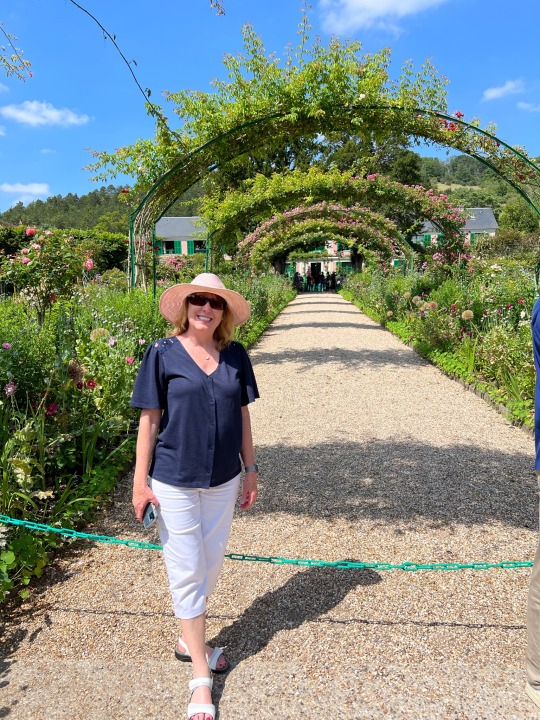






France Trip Day 11
Today was a lovely day! We spent the morning sailing down the Seine River, so we didn’t have any obligations. So, we were able to sleep in a little bit! Yay! For breakfast, the daily special was French toast! So we both got French toast in France! So good. I enjoyed a nice big pot of tea. We then sat in on a lecture about disembarkation and other things. Boo. I don’t want to go home! After the lecture, we decided to participate in the on-board exercises classes. First ones we’ve attended even though they’re offered every day. We went up to the roof top for the classes. It was a bit of a gloomy morning and it was raining a little bit too! So we ended up being the only crazy people working out on the roof top with Damien, the instructor. We did 30 minutes of resistance band training and then 30 minutes of line dancing. We started off with the Cupid shuffle and then did the wobble! We wobbled in the rain while sailing down the Seine river going through a river lock. It was so much fun. We also did the Macarena among other dances. It was a hoot. My mom then left to go get ready for lunch. I stayed and participated in their walk. If you do 16 laps on the top of the boat, it equals a mile! So I did that too.
For lunch, it was apparently “Paris” themed. All of the waitstaff was dressed in Parisian aprons and berets. We ate a light lunch because we knew we were going to have a big dinner. After lunch, we arrived in Vernon and had an afternoon tour planned for Monet’s gardens! Claude Monet bought this house and property in Giverny, France around 1880. We learned a lot about the life of Claude Monet and his family and Impressionism art style. We learned his art was not initially accepted in to art society due to it’s abstract-ness. We learned that photography helped aid the Impressionism movement. Prior to photography, painters tried to paint realism as it was the only way of recording visual things. Since photography was able to do that, art became more abstract. Monet was very interested in light and movement. He became a self-taught gardener and developed these beautiful gardens in his yard that he would then paint. He even diverted part of the Seine river to feed his Japanese water lily pond. He was also very inspired by Japan and collected Japanese art prints. So his second garden was inspired by Japan. We walked through his gardens and thoroughly enjoyed them! And it turned out to be beautiful weather! It stopped raining and the sun came out and the high was in the high 70s! It was gorgeous!!! We also walked around his home, which has been kept almost identical to when he was living in it! Very cool! We then did some shopping at the gift shop and local boutiques. I would have liked to continued walking around Giverny, but we had to go back to the boat. When the buses arrived back at the boat, we decided to just take a quick walk around the city center of Vernon. We learned that on June 21, every year, all over France, musicians play live music throughout the cities to celebrate the beginning of summer. And sure enough, we saw lots of locals out and about and a stage being set up for a concert. How fun!
We then headed back to the boat to get ready for dinner. Tonight was our Chef’s Dinner! Ama waterways has a special restaurant in the back of the boat with a more intimate setting and very fancy 7-course meal. We had to make a reservation for it earlier in the week. We both got dressed up for the dinner. My mom wore her new French dress she purchased yesterday in Rouen. We sat down for dinner and had a lovely view of the Seine river as the sun was going down. Dinner was amazing! So fancy! We started off with some really good white wine paired with a mozzarella and tomato and pesto dish. Very good. Second course was a tiger prawn shrimp on top of some hummus and vegetables. I did try it. Not a huge fan, but I tried it! Third course was a delicious creamy cauliflower soup with almonds and figs. Fourth course was a sea bass on top of sweet potato mash and turnips. Funny enough, I actually don’t mind sea bass. So I actually enjoyed the dish! Then we had a raspberry sorbet in a sparkling wine, which is used as a palate cleanser. Very good. Then we switched to a red wine and it was paired with a beef brisket with horseradish and vegetables. It was very good. Not the horseradish, but the rest of the dish. Then for dessert, we had a caramel tart, mango ice cream, and a lemon macaron. We also had a second dessert, which was some sort of vanilla-chocolate pudding bake because our dinner mates were celebrating their anniversary. All of the food was very very good. Small portions, but still, I’m stuffed! The food has been amazing all week! Highly recommend an Ama cruise for the food! We are now very full and are rolling into bed. It’s our last full day in France tomorrow! Boo! Hoping for a fun day though! We’re supposed to go on a nice bike ride!
1 note
·
View note
Photo

#Repost @paintings_i_love № 1887 Paul Signac (French, 1863-1935) Quai de la Tournelle oil on canvas, 46 x 65.4 cm. Painted in 1885 Private collection • The present painting dates from 1885, which saw Signac moving from the formal Impressionist style he had adopted in the early 1880s toward the Divisionist principles which would mark his subsequent oeuvre. The preceding year, he had co-founded the Salon des Indépendants and met Georges Seurat, whose Divisionist landmark, Une baignade à Asnières (De Hauke, no. 92), was shown at their inaugural Salon that May. Quai de la Tournelle is an admixture of these dual influences, with its dappled brushwork to the water set off by the planar stonework at lower left. The first recorded owner of the present work was Julien (Père) Tanguy, an amiable supplier of art materials to struggling Parisian artists in the late 19th Century, inluding Vincent van Gogh, who painted his portrait several times (e.g. De la Faille, no. F 263), and Signac. In lieu of payments his clients could ill afford, he would often receive drawings and paintings, in turn becoming an amateur dealer. The present work would remain in his collection until his death in 1894, featuring in his estate sale in June of that year. • #PaulSignac #Signac #postimpressionismo #postimpressionisme #oilpainter #oilpaintings #oilpainting #artforeveryone #fineartpainting #storiadellarte #peintures #historyofart #arthistory #beauxarts #instamuseum #artmuseum #pittura #arthistorian #peintre #malerei #19thcenturyart #20thcenturyart #oldmasters #impressionism #postimpressionism #europeanart #landscape https://www.instagram.com/p/Cd7UJVWo3MA/?igshid=NGJjMDIxMWI=
#repost#paulsignac#signac#postimpressionismo#postimpressionisme#oilpainter#oilpaintings#oilpainting#artforeveryone#fineartpainting#storiadellarte#peintures#historyofart#arthistory#beauxarts#instamuseum#artmuseum#pittura#arthistorian#peintre#malerei#19thcenturyart#20thcenturyart#oldmasters#impressionism#postimpressionism#europeanart#landscape
1 note
·
View note
Photo
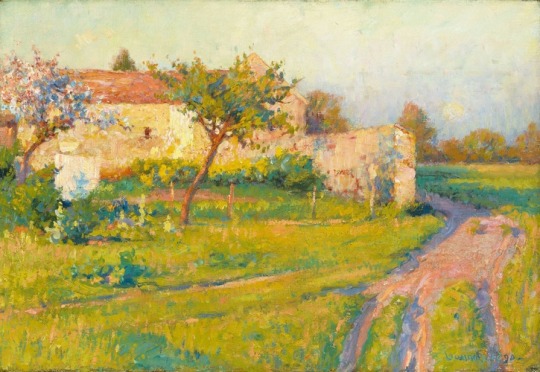
Spring in France, Robert William Vonnoh, 1890, Art Institute of Chicago: American Art
Robert Vonnoh was among the first American painters to explore Impressionism. He received his formative artistic training in Boston and headed to Paris in the early 1880s for further instruction. By the late 1880s, Vonnoh had settled in Grez-sur-Loing, a rural area outside of Paris that attracted a growing colony of artists who worked en plein air. Here, using a brilliant palette, broken brushstrokes, and unblended colors, Vonnoh captured the budding vegetation and warming sunlight of a spring day. Alongside intense greens, peaches and lavenders convey the dappled light and shadows of a winding road at right. Although no figures appear in Spring in France, the composition suggests a domestic setting, with fence posts delimiting a yard and white linens hanging from a nearby tree. Wirt D. Walker Fund
Size: 38.7 × 55.9 cm (15 1/4 × 22 in.)
Medium: Oil on canvas
https://www.artic.edu/artworks/97292/
2 notes
·
View notes
Text

At the Theater
It's me again ! I won't rest easy until I'm done filling the gaps in my 1880s wardrobe and evening wear sure was a big one. So here, come and look at these 1870's / 1880's evening bodices, 4 of them ! You're welcome, just don't use them for gardening or the historical fashion police will be on your back ❤️
More pics and download below
This set was inspired by 2 of Mary Cassatt's paintings : as referenced in the title, At the Theater, 1880 and Woman in a Loge, 1879.
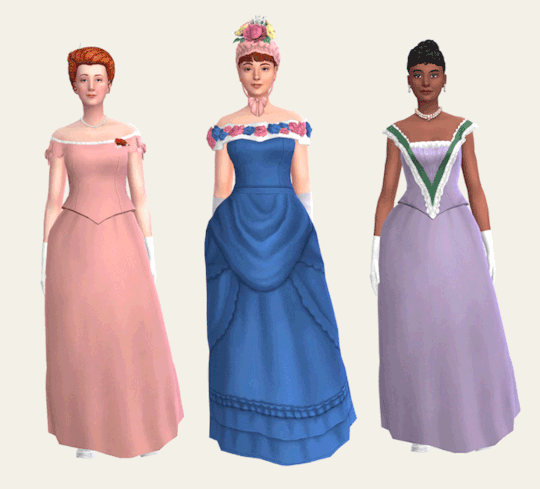
——————— Plain and Bow Bodices ———————

———————————————————————————
These 2 bodice are the ones that are most inspired by Mary Cassatt's paintings, but it's also a style I've seen a bunch in other impressionist paintings of the time. It's a simple sleek bodice with off the shoulder sleeves and a low rounded collar as was fashionable in the late 1870s and early 1880s.
It is specially made to be worn over my bustle skirts. An overlay is included to change the bow's color.
74 swatches for the bodices : 22 solids, 10 floral, 6 plaid, 25 striped & 11 polka dot patterns
22 solid swatches for the bow overlay
the bow overlay is in the right wrist section
Disclaimer :
1 -be aware there will be some distorsion in the armpit area, I did my best but armpit weights are tricky.
2 - the patterned swatches will not be seamless in that same armpit region as you can see below it's quite cluncky :
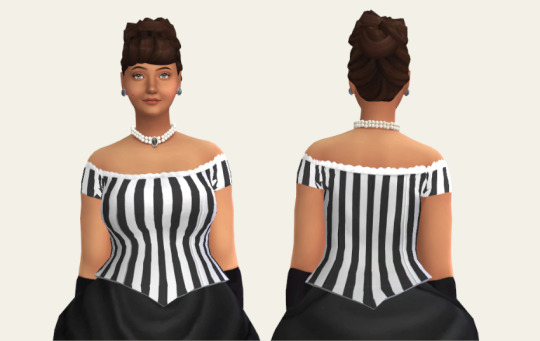
————————— Rococo Bodice —————————

———————————————————————————
This bodice, like the name implies, is inspired by Rococo fashion. The Rococo style dates back to the 18th century and it had a bit of a revival during the victorian era which impacted the fashion as much as the interior decor among other things. This influence, here, results in a squarish neck line and a triangle piece reminiscent of 18th century stomachers.
Like the the plain and bow bodices it has been specially made to be worn over my bustle skirts. An overlay is included to change the trim's color.
74 swatches for the bodice : 22 solids, 10 florals, 6 plaids, 25 stripes & 11 polka dots patterns
22 solid swatches for the Rococo trim overlay
the Rococo trim overlay is in the right wrist section
————————— Flower Bodice —————————

———————————————————————————
This bodice was mostly inspired by some fashion plates from 1880.
Contrary to the 3 others, I made it so it sits under the skirt, so it'll work with other bottoms than my bustle skirt too should you want to.
74 swatches for the bodice : 22 solids, 10 florals, 6 plaids, 25 stripes & 11 polka dots patterns
62 swatches with various color combinations for the flower overlay
the flower overlay is in the right wrist section
—————————— Boutonnière —————————

———————————————————————————
In addition to the flower accessories from my previous set, here is a boutonnière that sits lower on the chest to work with lower neck lines. Contrary to my previous boutonnière, this one is also compatible with necklaces. Like my other flower accessories, this is a pretty timeless accessory as evidence by the picture below.
Once again this is an edit of @the-melancholy-maiden's Hair Flowers Through the Ages Part 2 thanks to her very open TOU.

not compatible with hats
in the nose piercing section (so that it's compatible with necklace)
51 swatches : the-melancholy-maiden's original 29 colors and my 22 colors
available for female frames
———————————————————————————
Download : dropbox — simfileshare
———————————————————————————
And as a little bonus some of my reference main reference pictures :

#my cc#ts4cc#ts4 historical#ts4 clothes#ts4 accessories#sims 4 historical#sims 4 clothes#sims 4 accessories#maxis match#decade challenge#1880#clothes#timeless#accessories#teen#grown up#1880s Impressionism Sets
230 notes
·
View notes
Text
my long ass review for S32E03 Now Museum, Now You Don’t
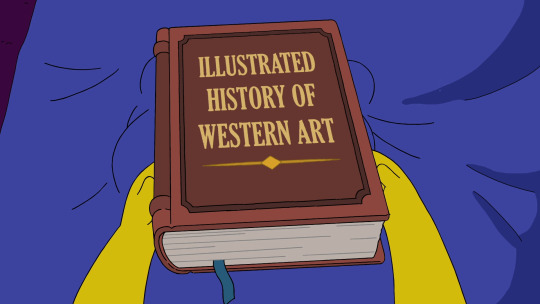
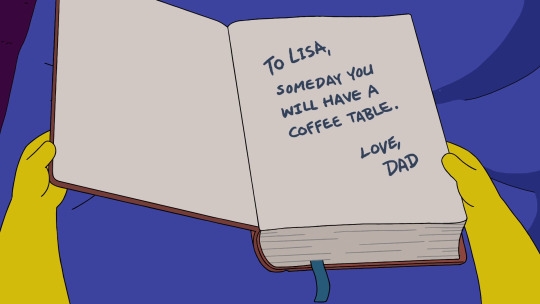
warning: LONG because i rambled about history more than i thought i would
id been looking forward to this one because i like art history, especially after seeing how they tried their best to stick to historical accuracy in the previous episode I, Carumbus. this time however….they didnt try that hard. i dont know why i thought theyd go through that sort of trouble again LMAO
but its okay, i dont really expect the simpsons to be the paragon of historical accuracy or anything. especially in anthology episodes told through a particular character's lens (in this case, lisa, whos already feverish so whatever)
first i just wanna say that this is, i guess, less of a review and more of an accidental list of history fun facts. so im just gonna get my general thoughts out of the way first.
the episode was fun! to me at least haha. i mean it got me to think and do a lot of research on my own so that must count for something. besides a couple of really weird ones, the jokes were good. anthology episodes tend to be….not that good but i thought this one was one of the better ones so far. idk.
anyway on to lisanardo da vinky
its the renaissance! jesus christ the italian accents in the beginning of this segment were annoying as hell but i also feel like that was the joke lmao. ill be real i kind of tuned out for a second there when grampa started rambling so idk what he said.
i told myself i wouldnt get nitpicky with historical accuracy if the jokes were funny (final edit: so that was a lie) but this meh bit with the pizza guys and mascots was really not worth ignoring the fact that its impossible for italy to have any tomato-based food in the 15th century (tomatoes were brought to europe from the americas in the 16th century, and pizza as we know it today—flatbread, cheese, tomato—originated in the late 18th century)

oh this next part was kind of legit tho. lisanardo, like the real leonardo, became andrea del verrochio's apprentice at his workshop. i loved this next bit:

"Whoever paints the sweetest cherub will have the honor of having MY name signed on their work. That's what great artists do!"

SO YEAH as it turns out, lisanardo painted the sweetest cherubs. the painting here is called The Baptism of Christ, and the real leonardo assisted verrochio in finishing it. specifically, he painted the cherubs in the corner.


this causes verrochio to quit and go someplace with less talented people: a music school (yes, verrochio did quit painting after getting owned by young leo and his mad angel painting skills. he never did anything with music tho, he was more of a sculptor)
alongside lisanardo, in mr largo-verrochio's workshop we have barticelli (botticelli bart), dolphatello (donatello dolph), ralphael (raphael...ralph) and mediocrito (no one that i know of. sorry milhouse) (and kearney i guess but they dont refer to him by name). botticelli and donatello are said to have also been apprentices at verrochio's workshop, but raphael came a couple of decades later so he couldnt have been there. and donatello was too old so that claim is a bit questionable. but anyway
it IS true that leonardo's peers envied him, to the point where he was anonymously and purposefully accused of being gay (a major crime punishable by death in 15th century florence) while he was still working at verrochio's workshop
we are then treated by what im pretty sure is the fourth time the show has used 'at seventeen' by janis ian, this time sung by a dejected lisanardo (man they really do keep making yeardley sing these days huh) who only wishes to be appreciated and not envied.
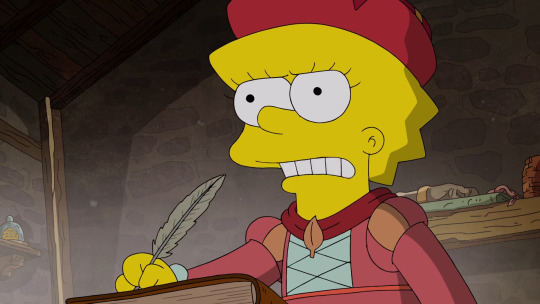
"I'll show them all! I'll show them all in a secret diary that no one will decipher for 400 years!"
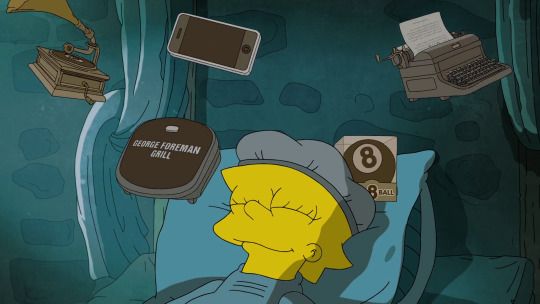
some of lisanardo's future inventions. who wouldve known
so after barticelli, for some reason (revenge??? or something?? what was his plan here idgi) steals lisanardo's diaries full of blueprints of her inventions and takes them to mr burns who i have to assume is pope alexander VI here, they decide to use her inventions for war.
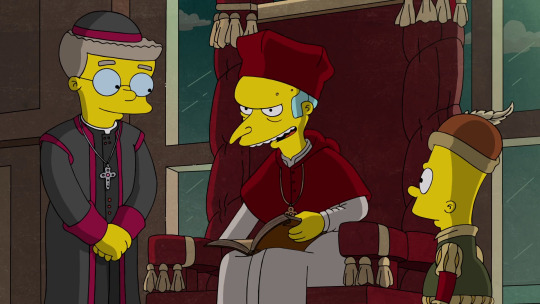
"With these, we can kill the most evil people in the world!! ....Slightly different Christians."
leo actually did this of his own accord. im surprised this is what they decided to do with lisanardo instead of talking about leo's love of nature and vegetarianism (not a single mention of that in this episode? come on...) then again, trying to do good only to end up indirectly making things worse is a very standard lisa storyline. i guess they didnt want to miss the chance to have evil pope burns (very fitting, especially for that era since they were all about money and controlling the people)
so lisanardo decides to leave for france, unlike the real leonardo who was more or less persuaded by his ultimate fanboy king francis I to move to france.
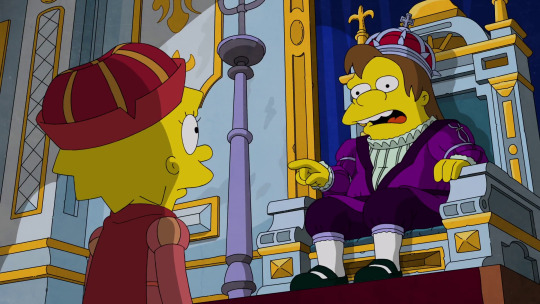
"Lisanardo, I have many questions. Why are you hitting yourself? A nerd says 'what'? And how is it possible that I am rubber and you are glue? Et cetera, et cetera."
that line may seem a little random, like hes just nelson saying nelson things (and i mean, obviously he is) but the real francis also "had an unquenchable thirst for learning, and Leonardo was the world’s best source of experimental knowledge. He could teach the king about almost any subject there was to know, from how the eye works to why the moon shines." so yeah, he did have many questions and lisanardo, finally being appreciated for her intellect, was happy to answer them all. its very interesting how lisa assigned this role to nelson in her retelling of da vinci’s life :^)
and so she lived the rest of her days in france, nat king cole's 'mona lisa' plays because duh, and they make a da vinci code reference because duh. and the segment ends. and not a single time did they show the actual mona lisa painting. the fuck?

(ngl i was fully expecting bart to say 'leonardo da vinky' for a second here)
so this next segment is about french impressionist painters, most likely the batignolles group, a name adopted by the early representatives of impressionism. its much more vague than the lisanardo segment since no one here is referred to by name (except moe, more on him in a sec) but i dont feel like it really matters in this case. bart is prrrrooobably claude monet but its hard to say, this segment is kind of a mish-mash of a lot of things.
also i gotta say i really liked how lisa introduced the story to bart with an 'if you hate the formal study of art' and not 'if you hate art' because thats exactly my headcanon. i LOVE the concept of artist bart and whenever its referenced it just makes perfect sense to me.
anyway the segment opens in 1863 at the école des beaux-arts (back then it was actually known as the académie des beaux-arts), preserver of traditional french art styles. skinner reviews his students’ paintings one by one. praises the plain, unimaginative paintings depicting your typical european countryside landscapes. very run-of-the-mill (haha get it...cuz theres….a windmill) (although the real académie didnt approve of such basic stuff, they wanted artists to draw epic historical and mythological scenes)
then he gets to barts painting and he gives him an F- because the painting made him think.

(the paintings in this scene arent real famous paintings as far as i know but they are inspired by real paintings enough to get the point across)
in comes barney dressed as bacchus as a model for the students to sketch, which i just loved:
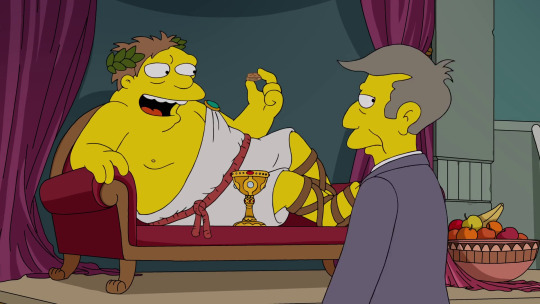
barney: “You prefer robe open or robe off?”
skinner: “Just cover your privates with this walnut shell.”
barney: “Whoa!!! So roomy!”
skinner gasps in horror at bart’s sketch, which “looks nothing like him” and bart explains that “it shouldn’t; we’re making the art that we feel because we can’t compete with a camera.” damn, you go bart. take that, realism. draw what you feel!!

(also no, you didnt need to hold still for 17 hours for a daguerreotype. 30 min tops.)
nelson haw-haw of the week: FOIE-gras!
so here they are at the moulin rouge (“enjoy it before baz luhrmann ruins it” hey shut up. i love that movie), which wouldnt be built for another 26 years, but it is the most widely known gathering place for bohemians in the public consciousness so i can understand why they went with the moulin. nelson delivers this anachronistic line:

“This époque keeps getting beller and beller!”
which alludes to la belle époque, the golden age of france usually dated from 1880 to 1914. made me snort so ill let that slide
and heres moe! as henri de toulouse-lautrec, who was actually born a year after the year this segment is set in. yo moe szyslak he was just 1
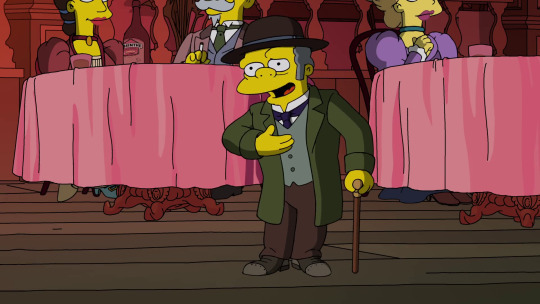
toulouse-moetrec introduces himself as the chronicler of the demimonde (not an actual job). an iconic figure associated with the moulin rouge (largely due to his affinity for alcohol and prostitutes), toulouse-lautrec was also a painter, having illustrated a series of posters for the moulin himself. he simply had to be in this segment, anachronisms be damned, just because they decided to include the moulin. cant have one without the other.
and yes he did have a walking cane where he kept his liquor.

i love how everyone drinks absinthe in this place. theyre bohemians what else would they drink
toulouse-moetrec points out that barts paintings are the greatest thing hes ever seen (and hes seen like five things!) and that hes a genius. milhouse realizes that they should stop doing what the teacher says and use their own minds to instead...start doing what bart says lmao. to the easels!
next we have skinner hyping up chalmers about the art his students made for the salon de paris, an art exhibition that the emperor of france will attend. he assures him that none of these paintings will encourage debate, provoke thought or be out of place at a dentist’s office. when they unveil the art, theyre both SHOCKED at how scandalous the paintings actually are.



this reaction was kind of accurate. impressionism was severely rejected at the salon de paris, due to paintings not looking finished enough to them, they thought they were ugly and vulgar for depicting nudity in a contemporary setting (historical and mythological nudity was fine). these impressionist paintings were sent to the salon de refusés, which is. yeah. the place where they sent the rejects. the salon de refusés does not make an appearance but this scene makes a reference to it when the artists get expelled from the royal salon. also:
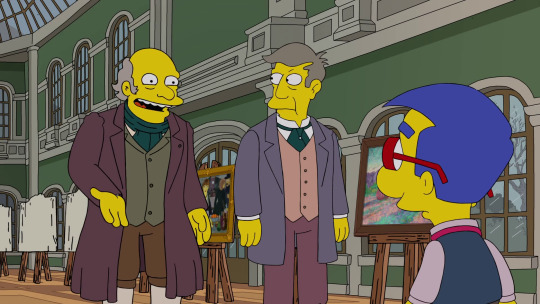
“What about our student loans?”
“Oh they’ll be refunded. We are not barbarians, I mean, come on.”
(god if only)
so the painters are down because they want the emperor to actually see their paintings. toulouse-moetrec pipes in once again with an idea.
“There is one thing the emperor loves more than anything.”
“France?”
“No, he hates France.”
apparently the emperor really loves cheese, which makes sense since its napoleon III (who loved cheese) and homer (who loves cheese.) so the painters roll into the salon inside a giant wheel of cheese (obviously.) as lenny said, “Eh, you know French cheese. Very runny.” napoleon III chases after the wheel into a room, where the wheel falls apart after getting chomped on by the emperor. now that they got his attention, the painters proudly show the emperor their impressionist art, which he couldnt be more indifferent about because he just wants to eat his cheese dammit, and he awards them with the royal medallion just to kind of get them out of his way. skinner immediately starts kissing ass (as he does) until marge’s like ‘hey wait a minute. you expelled these students from the royal salon’ and an executioner immediately starts ominously measuring skinners neck.
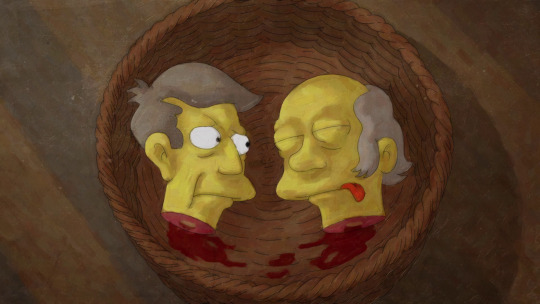
“Uh, sir...is your tongue sticking out because you’re dead or because you’re mad at me?”
and thats the end of that lmao (gore in this episode, gore in the last episode, and next week we’re getting gore too cuz its THOH, what the hell is goin on)
we get a short intermission with maggie, who wants a story for her too! lisa tells her that renaissance artists loved to put babies in their paintings, especially baby angels.
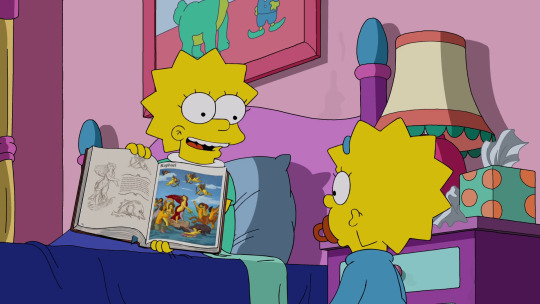
here she is showing her The Triumph Of Galatea by raphael:
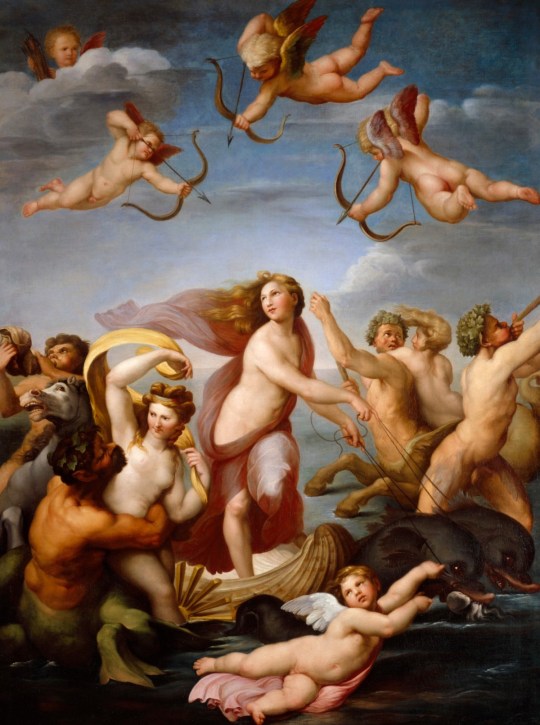
King David Playing The Harp by peter paul reubens:
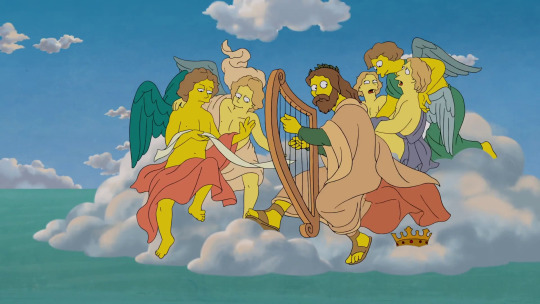

and a very simplified version of pretty much any depiction of hell by hyeronimus bosch lmao:
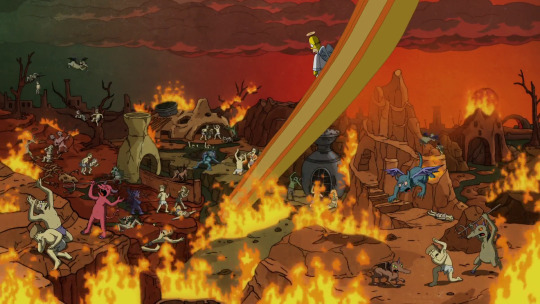
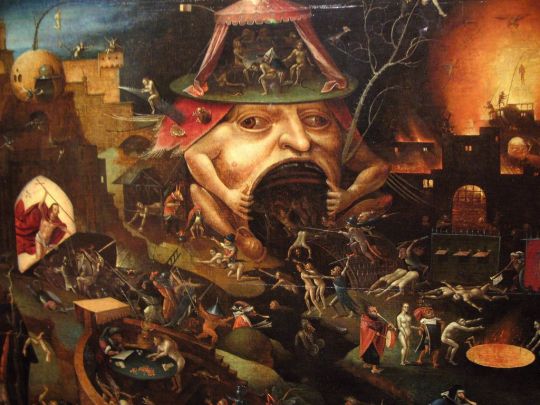
not much else to say about this one, really. but i really liked that sky!
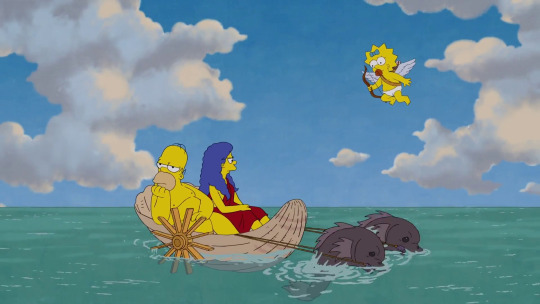
the last segment is about frida kahlo and diego rivera. or as bart puts it ‘the one about a fat guy whos wife is too good for him.’ i was REALLY looking forward to this one because i love frida and i thought itd be a cool opportunity for animators to go bonkers and do really cool shit with her art as inspiration…..but the segment is not about frida, its about diego and his selling out to capitalism. and its also yet another story with homer and marge drama. no funky cool animation here. sigh i guess i’ll take it
the story begins in 1929 at la casa azul, frida’s home (now museum dedicated to her life and work.) frida and diego are getting married. this courtyard definitely did not look this way yet back in 1929. also theres something very cringy yet funny about lovejoy saying spanish words the way he does, i honestly cant decide how i feel about that one

the writers know theyre being cringy with their gringoness so they go along with it.
moe: “Spanish for ‘best wishes’!”
mel: “Spanish for ‘congratulations’!”
bumblebee man: “Spanish for ‘muy bueno’!”
OH YEAH BUMBLEBEE MAN this is his new voice actor, eric lopez! hes not mexican but its still great to finally have a latino actor voicing a latino character and hes very excited to be part of the show so i hope to hear more of him!! im rooting for him
el barto/zorro makes an appearance which i am very confused about. he has jack shit to do with frida and diego and mexico in the 20s-30s. el zorro was set in the spanish california of the early 19th century. their use of the original theme song makes me think they just wanted to flex their disney privileges tbh

lets not talk about that that whole scene was bad
anyway diego announces he and frida are going to new york, without even asking her first. frida is obviously pissed.
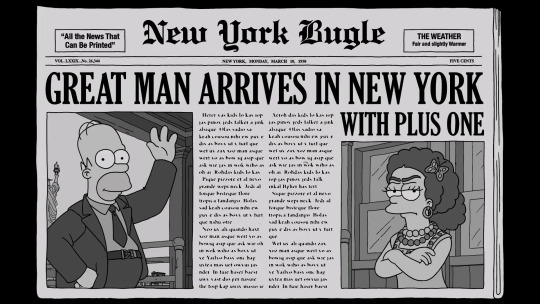
“Don’t worry, as a woman, you’ll be treated with much more respect in America.”
so in new york, diego is having a bit of a business meeting with mr burns as one of the members of the rockefellers, who is commissioning him to draw a mural for the rockefeller center. its kinda funny how he refers to him and frida as socialists even though they were very much communists lmao its okay you can say it. ok so far, but then frida says ‘yes, we hate the capitalists! right now, a young socialist is being born who will take them down! mr. bernie sanders. i hope hes quick about it’ and that was a simple enough joke and couldve been left at that but then its immediately followed by this weird as fuck family guy-esque cutaway gag to bernie as a baby:
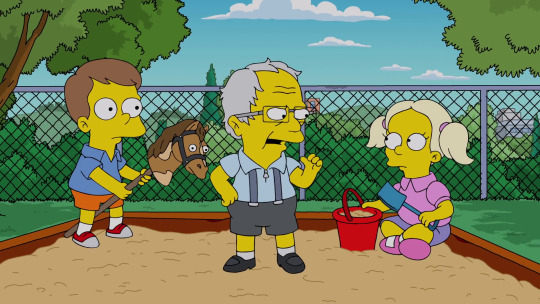
“Getting a cootie shot should not cost your lunch money. And if you don’t listen to me, listen to the Bernie Babies! What? Everybody’s got goons.” *larger babies start beating up this other baby* “I disavow that, and welcome it.”
this confused me so much that i had to ask one of my american friends to help me understand, but even she was like ‘uhhh yeah thats a weird joke,’ especially now that hes been out of the race for months (then again these episodes take almost a year to produce. i guess they couldnt be bothered to replace it with something more relevant.) whatever that was weird and confusing and unfunny moving on
frida is pretty irked that diego is going through with this deal. after all, it goes against everything they believe in. im not sure how the real frida felt about diego doing the mural, but she did feel a bit of rage during her visit to the united states, especially the obvious disparity between rich and poor. she hated having to interact with capitalists and found americans very boring. in this segment, frida seems to be acting more like the american communist party, which diego got kicked out of for accepting commissions from wealthy patrons. in any case, frida is pretty upset about this whole thing.
and finally we get the first and only kind of surreal frida moment. kinda. maybe. its more cartoonish than anything but im desperate ok


interesting how they felt like they had to add a “don’t smoke” in big letters after showing patty and selma flying away on their giant cigarettes. i wonder if this is something theyre making them do now? i remember hearing something about them toning down patty and selma’s smoking
diego comes home to frida, drunk as hell, followed by the marx brothers. i cant believe they didnt make a marxism joke come on it was RIGHT THERE. THE MARX BROTHERS. KARL MARX. COME ON

frida paints her feelings.
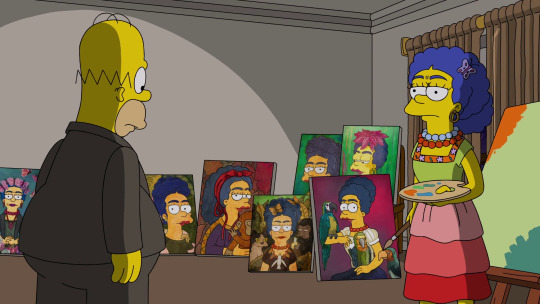
this makes diego realize that frida is a genius and he is not half the artist she is. he proclaims he will now show his awe of her by sleeping with other women, starting “an hour ago.” to which frida replies, “and i will start sleeping with other women, starting two hours ago.” yes this was pretty much their relationship. though im just wondering how the hell did diego not know frida was this kind of artist until now? i know homers an idiot but jeez. art was how frida and diego met, diego knew from the get-go that frida was an incredible artist. i guess the fame got to his head or something. again, homer just being stupid.
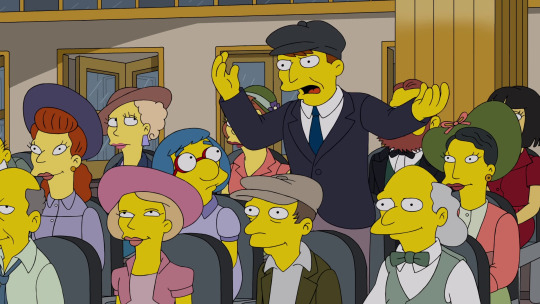
“well enough already, while the art is still deco, okay?”
its time for the mural diego painted, Man At The Crossroads, to be unveiled:
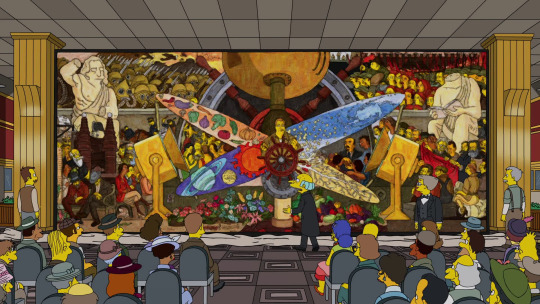
rockefeller examines it. good and great so far, and then...uh oh
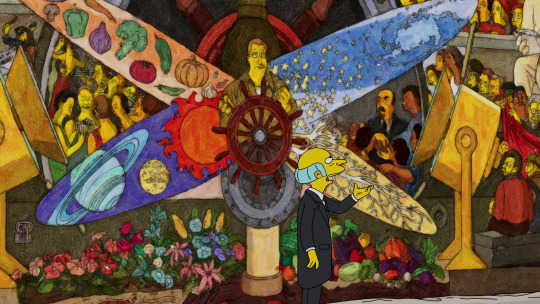
“Who’s that fellow…? With the beard, and the bolshevik smile…”
“That’s the founder of Soviet Russia, Lenin!”

“B-b-but he’s a communist!”
“Oh he just attended a couple of meetings.”
rockefeller will not have this communist in the temple to capitalism that is the rockefeller center, so he orders diego to paint over it. diego stands his ground and refuses. despite rockefeller’s threats, diego says that theres only one person he wants to be proud of him no matter what and in true homer & marge fashion, frida is touched by this. they happily leave the rockefeller center.
now, the real story of Man At The Crossroads and the rockefeller center was actually not that different. as soon as the rockefellers found out diego had snuck in a portrait of lenin into the mural, they ordered him to paint over it, to which he refused. diego even offered to include abraham lincoln and even american abolitionists in the mural as a compromise, but the rockefellers simply did not want any references to communism whatsoever. they did not complain about the hammer and sickle, though. yes, they did know diego was a communist and hired him anyway. what did they expect? lmao. diego said:
"Rather than mutilate the conception [of the mural], I shall prefer the physical destruction of the conception in its entirety, but preserving, at least, its integrity."
so they decided to destroy the mural before it was even finished and they never talked to each other again.

diego then repainted the mural at the palacio de bellas artes back in mexico, this time known as Man, Controller of the Universe. this new version included even more communist leaders and a depiction of john d. rockefeller jr. drinking at a nightclub, right underneath a depiction of syphilis bacteria. cue nelson haw-haw:
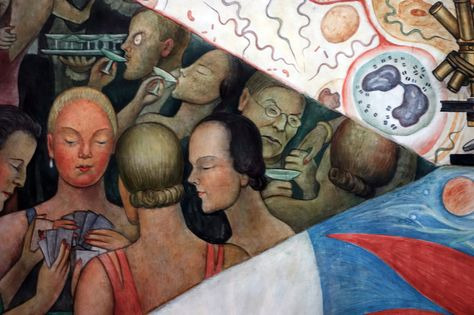
this was the version they used in the episode also, since the original was, well, never finished and also destroyed. only a black and white photograph of it exists, taken by diego before it was destroyed so he could remake it.
right so, homer!diego then pulls a Barthood and finishes the episode with a large mural summarizing the entire episode. he says some rick and morty thing i didnt get because i dont watch the show idk idc

the end
ALRIGHT NOW ITS TIME FOR THE STORY OF VINCENT VAN MOE
#if you read all of this bless you#the imageless gdocs version of this is 8 pages long#hope you...enjoy?!?! these art history fun facts?!?!#dont let me do something like this again but also let me know if i should do something like this again#i was really only motivated to do this because im already passionate about the subject so idk if i could do it otherwise#anyway. this took me all day yesterday because the power kept going out#but im finally done#bye
54 notes
·
View notes
Photo
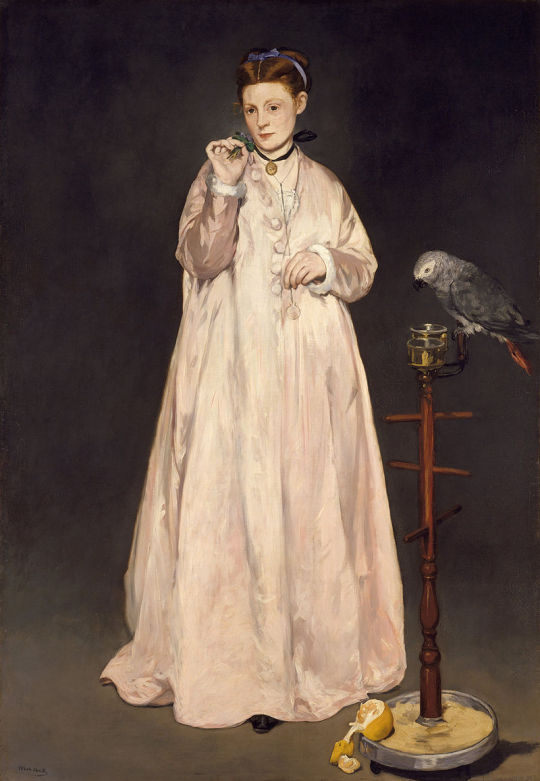


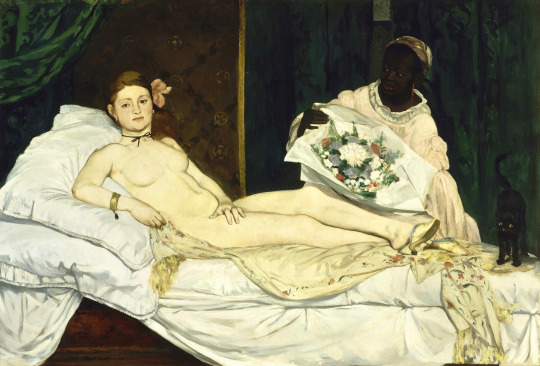
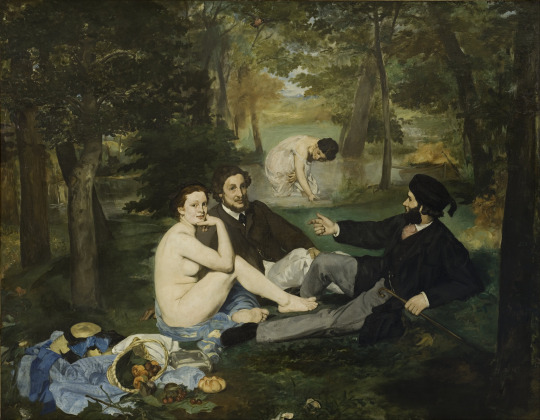
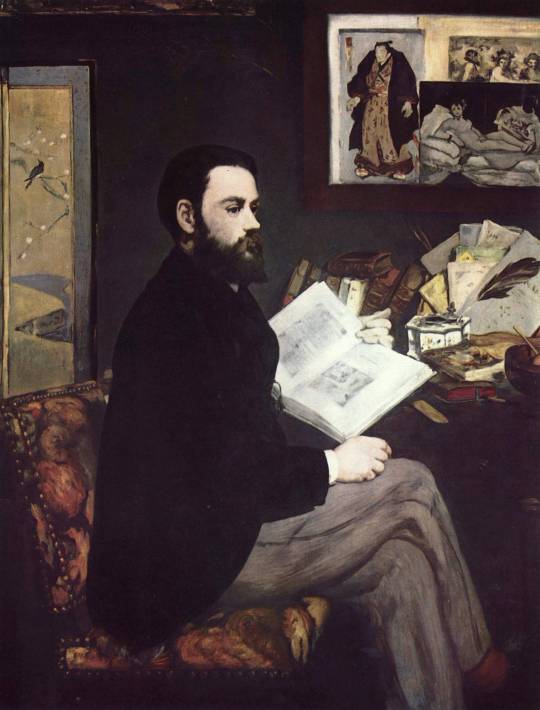

Édouard Manet French: 23 January 1832 – 30 April 1883) was a French modernist painter. He was one of the first 19th-century artists to paint modern life, and a pivotal figure in the transition from Realism to Impressionism.
Born into an upper-class household with strong political connections, Manet rejected the future originally envisioned for him, and became engrossed in the world of painting. His early masterworks, The Luncheon on the Grass (Le déjeuner sur l'herbe) and Olympia, both 1863, caused great controversy and served as rallying points for the young painters who would create Impressionism. Today, these are considered watershed paintings that mark the start of modern art. The last 20 years of Manet's life saw him form bonds with other great artists of the time, and develop his own style that would be heralded as innovative and serve as a major influence for future painters.
Le Déjeuner sur l'herbe ( Luncheon on the Grass )
A major early work is The Luncheon on the Grass (Le Déjeuner sur l'herbe), originally Le Bain. The Paris Salon rejected it for exhibition in 1863, but Manet agreed to exhibit it at the Salon des Refusés (Salon of the Rejected) which was a parallel exhibition to the official Salon, as an alternative exhibition in the Palais des Champs-Elysée. The Salon des Refusés was initiated by Emperor Napoleon III as a solution to a problematic situation which came about as the Selection Committee of the Salon that year rejected 2,783 paintings of the ca. 5000. Each painter could decide whether to take the opportunity to exhibit at the Salon des Refusés, less than 500 of the rejected painters chose to do so.
Manet employed model Victorine Meurent, his wife Suzanne, future brother-in-law Ferdinand Leenhoff, and one of his brothers to pose. Meurent also posed for several more of Manet's important paintings including Olympia; and by the mid-1870s she became an accomplished painter in her own right.
The painting's juxtaposition of fully dressed men and a nude woman was controversial, as was its abbreviated, sketch-like handling, an innovation that distinguished Manet from Courbet. At the same time, Manet's composition reveals his study of the old masters, as the disposition of the main figures is derived from Marcantonio Raimondi's engraving of the Judgement of Paris (c. 1515) based on a drawing by Raphael.
Two additional works cited by scholars as important precedents for Le déjeuner sur l'herbe are Pastoral Concert (c. 1510, The Louvre) and The Tempest (Gallerie dell'Accademia, Venice), both of which are attributed variously to Italian Renaissance masters Giorgione or Titian. The Tempest is an enigmatic painting featuring a fully dressed man and a nude woman in a rural setting. The man is standing to the left and gazing to the side, apparently at the woman, who is seated and breastfeeding a baby; the relationship between the two figures is unclear. In Pastoral Concert, two clothed men and a nude woman are seated on the grass, engaged in music making, while a second nude woman stands beside them.
Olympia
As he had in Luncheon on the Grass, Manet again paraphrased a respected work by a Renaissance artist in the painting Olympia (1863), a nude portrayed in a style reminiscent of early studio photographs, but whose pose was based on Titian's Venus of Urbino (1538). The painting is also reminiscent of Francisco Goya's painting The Nude Maja (1800).
Manet embarked on the canvas after being challenged to give the Salon a nude painting to display. His uniquely frank depiction of a self-assured prostitute was accepted by the Paris Salon in 1865, where it created a scandal. According to Antonin Proust, "only the precautions taken by the administration prevented the painting being punctured and torn" by offended viewers.[9] The painting was controversial partly because the nude is wearing some small items of clothing such as an orchid in her hair, a bracelet, a ribbon around her neck, and mule slippers, all of which accentuated her nakedness, sexuality, and comfortable courtesan lifestyle. The orchid, upswept hair, black cat, and bouquet of flowers were all recognized symbols of sexuality at the time. This modern Venus' body is thin, counter to prevailing standards; the painting's lack of idealism rankled viewers. The painting's flatness, inspired by Japanese wood block art, serves to make the nude more human and less voluptuous. A fully dressed black servant is featured, exploiting the then-current theory that black people were hyper-sexed.[4] That she is wearing the clothing of a servant to a courtesan here furthers the sexual tension of the piece.
Olympia's body as well as her gaze is unabashedly confrontational. She defiantly looks out as her servant offers flowers from one of her male suitors. Although her hand rests on her leg, hiding her pubic area, the reference to traditional female virtue is ironic; a notion of modesty is notoriously absent in this work. A contemporary critic denounced Olympia's "shamelessly flexed" left hand, which seemed to him a mockery of the relaxed, shielding hand of Titian's Venus.[10] Likewise, the alert black cat at the foot of the bed strikes a sexually rebellious note in contrast to that of the sleeping dog in Titian's portrayal of the goddess in his Venus of Urbino.
Olympia was the subject of caricatures in the popular press, but was championed by the French avant-garde community, and the painting's significance was appreciated by artists such as Gustave Courbet, Paul Cézanne, Claude Monet, and later Paul Gauguin.
As with Luncheon on the Grass, the painting raised the issue of prostitution within contemporary France and the roles of women within society.
A Bar at the Folies-Bergère (Un Bar aux Folies-Bergère), 1882, Courtauld Gallery, London
In his last years Manet painted many small-scale still lifes of fruits and vegetables, such as Bunch of Asparagus and The Lemon (both 1880). He completed his last major work, A Bar at the Folies-Bergère (Un Bar aux Folies-Bergère), in 1882, and it hung in the Salon that year. Afterwards, he limited himself to small formats. His last paintings were of flowers in glass vases.
Manet's public career lasted from 1861, the year of his first participation in the Salon, until his death in 1883. His known extant works, as catalogued in 1975 by Denis Rouart and Daniel Wildenstein, comprise 430 oil paintings, 89 pastels, and more than 400 works on paper.
The grave of Manet at Passy
Although harshly condemned by critics who decried its lack of conventional finish, Manet's work had admirers from the beginning. One was Émile Zola, who wrote in 1867: "We are not accustomed to seeing such simple and direct translations of reality. Then, as I said, there is such a surprisingly elegant awkwardness ... it is a truly charming experience to contemplate this luminous and serious painting which interprets nature with a gentle brutality."
The roughly painted style and photographic lighting in Manet's paintings was seen as specifically modern, and as a challenge to the Renaissance works he copied or used as source material. He rejected the technique he had learned in the studio of Thomas Couture – in which a painting was constructed using successive layers of paint on a dark-toned ground – in favor of a direct, alla prima method using opaque paint on a light ground. Novel at the time, this method made possible the completion of a painting in a single sitting. It was adopted by the Impressionists, and became the prevalent method of painting in oils for generations that followed. Manet's work is considered "early modern", partially because of the opaque flatness of his surfaces, the frequent sketchlike passages, and the black outlining of figures, all of which draw attention to the surface of the picture plane and the material quality of paint.
The art historian Beatrice Farwell says Manet "has been universally regarded as the Father of Modernism. With Courbet he was among the first to take serious risks with the public whose favour he sought, the first to make alla prima painting the standard technique for oil painting and one of the first to take liberties with Renaissance perspective and to offer "pure painting" as a source of aesthetic pleasure. He was a pioneer, again with Courbet, in the rejection of humanistic and historical subject-matter, and shared with Degas the establishment of modern urban life as acceptable material for high art."
Art market
The late Manet painting, Le Printemps (1881), sold to the J. Paul Getty Museum for $65.1 million, setting a new auction record for Manet, exceeding its pre-sale estimate of $25–35 million at Christie's on 5 November 2014. The previous auction record was held by Self-Portrait With Palette which sold for $33.2 million at Sotheby's on 22 June 2010.[38]
https://en.wikipedia.org/wiki/%C3%89douard_Manet
8 notes
·
View notes
Text
So, who wants to hear me gush about something in Blindspot that was almost certainly completely meaningless?
What is it, you (didn’t) ask?
It’s this.
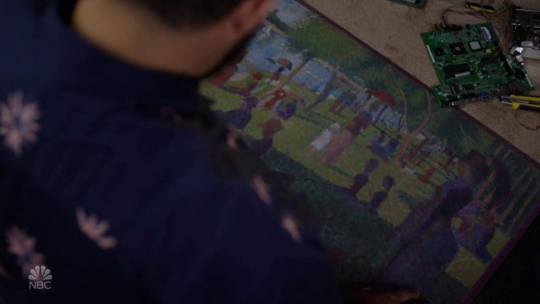
So, let me start by saying that this scene was one of my favourite scenes of Blindspot, like ever. I am living for the friendship that is forming between these two, and the way they are helping each other through their individual traumas. The added dimension of former CIA agent Tasha helping Rich recover from his torture at the hands of the CIA is just so perfect, not to mention they have the added connection of knowing what it’s like to be a ‘bad guy’ operating outside the law.
(I also like to think that Jane and Tasha talked together about how to help Rich, but since Jane was already supporting her hubby as well as carrying the team, Tasha took the reins on this one.)
But even though I totally could gush about that scene (especially that hug omg), that’s not actually what this post is about. This post is about me being a HUGE NERD for IMPRESSIONISM.
(Still sure you want to get into this lol?)
Alright then, here goes:

So, this absolute classic is probably at least vaguely familiar to a lot of people; it’s A Sunday on La Grande Jatte by Georges Seurat, painted in the mid 1880s, and arguably his most famous work.
(While watching the ep I initially took it for a Monet at first glance, which is super embarrassing for me but also I can’t help that I have this like Pavlovian response to Impressionism that makes me go YO IS THAT MY BOY MONET YOOOO the moment I see any painting even remotely of the style lol)
But let me tell you why I am losing my nerdy marbles over the use of this artwork in the show (even though I am very certain that they probably just used whatever relatively recognisable piece they could find that didn’t have any like copyright stuff attached) because oh boy do I have Thoughts.
So let’s get analytical up in this biz....
First off, there’s the big one: it’s an Impressionist piece. The very foundation of the style is that from afar, all looks normal, but when you actually look closely, everything is blurred and distorted; nothing is distinct. Which is doubly appropriate for this show: firstly, the team is currently pursuing a mission that seems clear-cut (to clear their names and get their lives back, to free the FBI of Madeline’s corruption) but which actually involves a lot of uncertainty and murkiness and blurred lines (are we willing to break multiple laws? to potentially kill people deliberately, not just in self-defense? how far are we willing to go to achieve our mission, and if we succeed, will we still be the same? etc). Secondly, and more relevantly to this particular scene, the style is fitting for Rich himself following his experience in the blacksite. Look from a distance, and he seems alright, still normal (or as normal as Rich could ever be). But look close, and you start to see that everything is actually hazy and muddled, the cracks starting to show. He is not okay.
But wait, there’s more! Because this work isn’t just Impressionist, it’s Neo-Impressionist (specifically, Pointilist) which ol’ boy Georges was one of the pioneers of-- he was literally considered a renegade because of it, a rebel operating against the status quo, which I find very appropriate for our own little band of rebels lol. But the point (lol) of Pointilism is to create scenes filled with vivid colours, ones that almost seem to jump out of the canvas, which is achieved by combining small brushstrokes (points) of different colours which from further away appear to be practically just one bright colour. So again, looking from a distance you see one thing, and from up close you see that it’s actually more complicated than that. Like this team; they’re all individuals, all their own distinct colours, but look at the bigger picture and you see that they blend together to create a balanced, harmonious whole. And that same concept can be applied to them all individually, too-- each one of them is made up by a veritable rainbow of traits. Light, dark, and everything in between; every stroke makes them who they are.
But that’s just the style, though, which is only the half of it. Look at the actual subject of the painting; at its setting. Art is an escape from one’s own reality, and for someone practically trapped in a concrete box underground, what better choice of escape is there than a scene of people happily enjoying the outdoors, spending time in the midst of sunshine and nature, with no walls or ceilings in sight, no one being hunted or hurt? See, too, how the foreground of the painting is in shadow-- it gives the sense that the viewer is in shadow too, the dimness of the bunker and the shadow of the painting blending together, like if Rich were to stand in front of the painting and step forward, he’d be stepping out onto the grass. It’s a hopeful thought; the team might be in shadow right now, but the light of day isn’t so far away. A little longer, a little further, and they’ll be out there too, enjoying their lives and their freedom just like the people in the painting.
And speaking of the people in the painting... there’s a few other little things about this painting that makes me love that it was the one they chose. Firstly, I love that Tasha brought Rich a painting which was described with words like ‘bedlam’, ‘scandal’, and ‘hilarity’ when it was first exhibited, which are probably the exact words that would come to mind if you had to describe Rich and his life in three words lol (pre-blacksite, sadly). Though the painting looks very normal and serene to us, when you look closely, there are a couple of pretty weird things, especially for that time. For one, the woman in the foreground has a pet monkey on a leash, which I think is a fairly apt representation of Rich’s role in the team haha, particularly early on. There’s also a lady off to the left who is fishing, and if I remember correctly, she was thought to symbolise a prostitute reeling in her clients down by the docks/waterside lol, an interpretation which I feel like Rich would absolutely love. In a more Blindspot-specific sense, another character of interest is the man lounging right near the front-- I can’t be the only one who thinks he looks just like ‘old’ Weller, right down to the little hat? The fact that his outfit seems out of place for the time, and also the subtle... sexiness (for the lack of a better word lol) of his clothes and pose makes it feel like Rich’s consciousness could have conjured him there (bc lbr, we all know Rich loves some sexy Weller). And lastly, I can’t not mention the little girl in the center, who is famously considered to be staring right at the viewer of the painting, as if fully aware she’s being observed and totally ready to throw down about it. And I know that this one is extra silly and had obviously never crossed the prop-designer’s mind, but, well... this painting is French, and if someone asked me to think of an appropriate name for a little French schoolgirl, I would pick the name of the one I spent many hours of my childhood watching cartoons and reading books about: Madeline.
As a last, final bonus (and yet another totally irrelevant thing that I am ascribing my own meaning to), just look out on the water in the distance-- there’s what appears to be a steamboat. Or is it The Boat, and is it sinking, a plume of smoke rising from it as it goes down in flames?
But that’s the thing about art, isn’t it; there’s no limit to what we see in it. So when Rich looks at this gift, I hope he sees freedom. Hope. A future in the sun.
Because he’s earned it.
They all have.
#Blindspot#Blindspot spoilers#Impressionism#LOOK I KNOW THIS IS RIDICULOUS#BUT I JUST LOVE IMPRESSIONISM OKAY#AND SYMBOLISM#AND RICH#AND THIS SCENE#don't ask me anything about literally any other art style bc I would not have a clue#god I'm so curious to know if the choice was even slightly deliberate#it won't be#but still
50 notes
·
View notes
Text
Week 7 Blog
Just less than seven weeks ago, we started off in the 13th century, and now we’re already exploring 20th century art with Realism and Impressionism. I must say, personally, these works are more up my alley as I tend to experience recency bias. Of course, before I get started, it is important to note that the industrial revolution has kicked off and that technology is starting to increase at a rapid pace. In this blog, I will analyze main points from chapters 23 and 24 of the textbook while relating them to the experiences of my own life.
Starting with Realism, in France, we have Rosa Bonheur whom used Realism with a touch of romanticism (which we talked about last week) in her work, The Horse Fair. This painting, which is oil on canvas, has some of the most real-life anatomy of animals and humans to the date of 1853. This painting portrays “… the struggle between humanity and untamed forces of nature (416).” Horses in this painting, of all different colors, are rumbling down a dirt path, some bucking in the air, and humans are trying to contain them by grabbing their headgear. The detail of the sky being dark, and the muscles of the horses being flexed as they are exerting massive amounts of energy is so realistic, much like nothing that we’ve seen before up to this point.
Traveling across the North Atlantic Ocean, we have examples of Realism in America with Mathew Brady. Brady is a very interesting character as he is known to have taken more than a third of the 100 known photographs of President Lincoln. One of the most notable photos of Lincoln that Brady took was “Cooper Union.” This photo was taken in 1860, with Lincoln standing straight-up, wearing a trench jacket, with a straight face. Lincoln’s left hand is firmly set on a pile of books, which is said to have given the photo a touch of Lincoln’s intellectual side as well as his serious side with his straight face (thus making this Realism). It is important to note that Realism in this time seems to be a world-trending phenomenon, even in forms of architecture with the Brooklyn Bridge and Eiffel Tower.
Shifting into Impressionism, in France again, we have Claude Monet, who, “…embodied the technical principles of Impressionism” more than any other artist at the time (439). The perfect piece to describe Impressionism is Monet’s Impression: Sunrise. This piece is oil on canvas, which depicts a boat on a body of water surrounded by trees during a sunrise. It has the famous silhouette of the sun onto the water, as well as the trees. One thing different about this piece is that the strokes are thicker than most impression pieces such as Monet’s Terrace at Sainte-Adresse, which is also an oil on canvas, impression. This piece looks almost like a low-resolution photograph, with its very thin strokes.
Heading back to America again, we also see Impressionism. John Singer Sargent, whom happened to live in Paris in the early 1880’s (448), had several great American renditions of Impressionism. One of the most popular, Breezing Up. This oil on canvas painting portrays an older man and three young men in the ocean on a boat, with the boat riding on its side nearly, and a flare of sun on the left side of the painting. Everyone in the photo is calm, and thin strokes appear to be used. Following the trend of many Impression paintings.
Overall, we see some trends with Realism and Impressionism. Both seem to start in France and creep over to America. Both also seem to be applied on oil on canvas paintings. Lastly, most can apply to almost any real-life depiction of humanity. I am very surprised by how far the anatomy and proportions of anatomy has come along with things such as the planes used in paintings, and the linear-perspective. This art seems to build on itself, using themes of the past, to build and become more REAL.
2 notes
·
View notes